










LIVE AUCTION • OCTOBER 25, 2025 • 1 P.M. CST P Bar S Ranch, Sand Springs, Oklahoma
SCHEDULE OF EVENTS:
FRIDAY, OCTOBER 24
3:00 p.m. Cattle available for viewing and refreshments
SATURDAY, OCTOBER 25
8:00 a.m. Coffee and pastries and cattle available for viewing 11:00 a.m. Complimentary lunch
1:00 p.m. Proof of Progress XIX Sale SELLING 57 LOTS

AUCTIONEER: C.K. “Sonny” Booth BID & VIEW ONLINE: CCi.live
Overlook Dr. Sand Springs, OK 74063 www.pbarsranch.com Paul Sisemore, Owner Manager: Elgin Elmore, 918-346-2438 elginpbars@yahoo.com





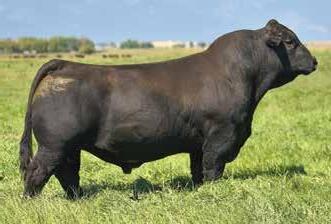






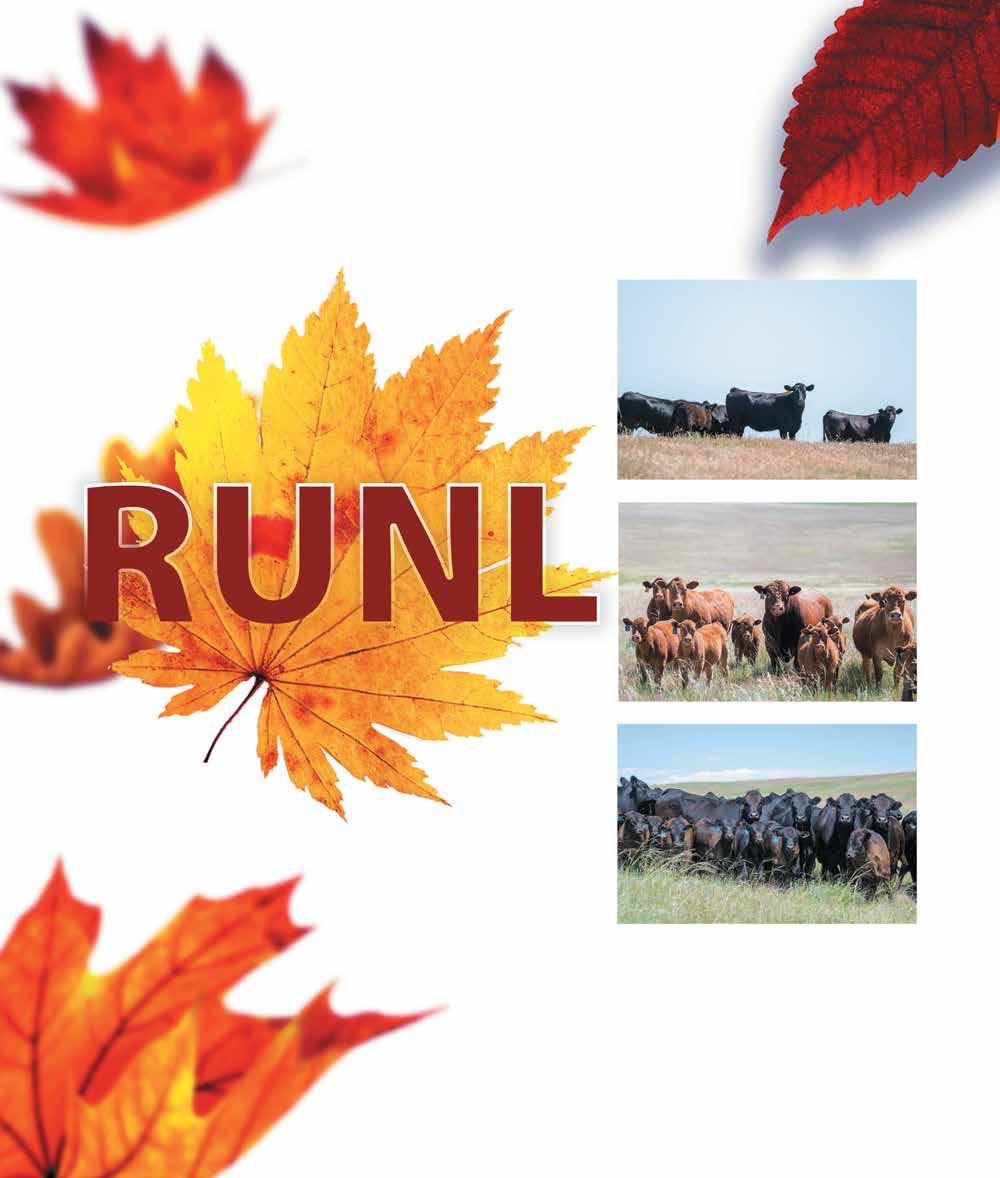






SALE MANAGEMENT:
MC MARKETING
KILEY McKINNA (402) 350-3447
WILEY FANTA (320) 287-0751
This promises to be our best yet. We have assembled our very best bred females, pairs, opens, bulls and genetic packages for this year’s event. We will be offering the kind of genetics to propel your program ahead during these good times in the cattle business.
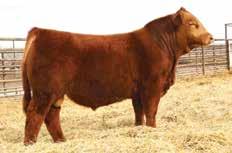






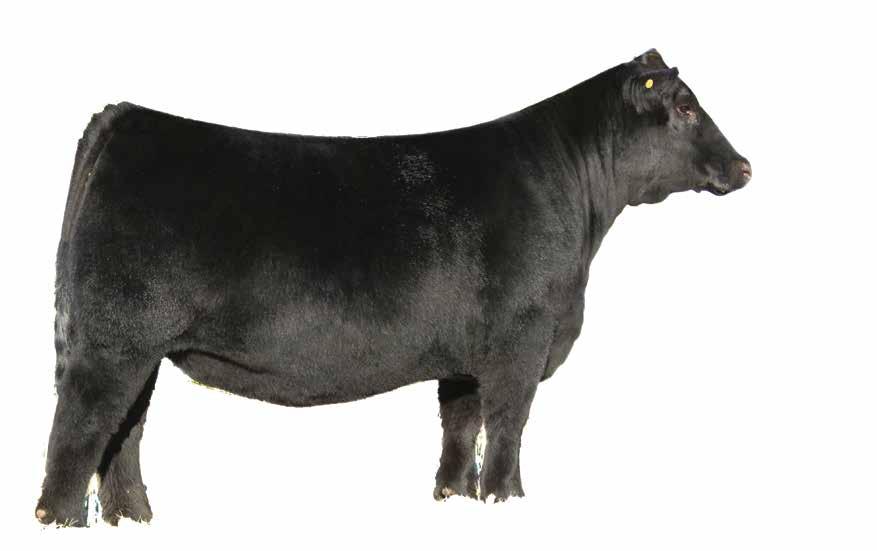





by Austin Hager
attle prices continue to set record highs in the commercial cattle market throughout the United States. This has provided a tremendous and needed boost to seedstock producers as well. The higher markets have no doubt increased prices we receive for our bulls produced for the commercial cattlemen, and has also allowed us to take advantage of those prices as we cull the bottom end of our herds as well.
Expansion of the nation’s beef herd throughout the country appears to remain slow to start. This is also evident in our registrations. Although memberships remain strong in the association, you can see the impact of the higher market incentivizing folks to cull inferior cattle to take advantage of the elevated prices. That’s just good business, but as we take a long-term approach to our planning, it is important to keep in mind how we take advantage
PRESIDENT, Austin Hager ...................................... Karlsruhe, ND 701-626-2345 • hagercc@srt.com
VICE PRESIDENT, Joey Freund Elizabeth, CO 303-841-7901 • freundjoe@outlook.com
SECRETARY, Ronn Cunningham .................................... Rose, OK 918-629-9382 • colronn@yahoo.com
TREASURER, Lance Sennett .................................. Waynetown, IN 765-366-4894 • lasennett@att.net
AT-LARGE, Jerry Wulf ............................................ Hancock, MN 320-491-1390 • jerry.wulf@wulfcattle.com
EX-OFFICIO, Bruce Lawrence ................................................ Anton, TX 806-790-2535 • bll1@speednet.com
DIRECTORS
Bart Mitchell, Boscobell, WI, 608-553-8070, springcreeksbart@gmail.com
Jay Wilder, Snook, TX, 979-268-5491, jwwilder1993@gmail.com
George Hubbard, Welch, OK, 918-541-5482, georgerhubbard@gmail.com
Matt Spangler, Lincoln, NE, 402-472-6489, mspangler2@unl.edu
Troy Gulotta, Independence, LA, 985-662-1561, liveoakcattle@gmail.com
Kevin Ochsner, Kersey, CO, 970-396-5525, kevinkochsner@gmail.com
Rob Brawner, Wood Lake, NE, 402-376-4465, bulliscreek@gpcom.net
Mark Haden, Rogersville, MO, 417-838-6109, buckridgecattle@gmail.com
Trent Coleman, Charlo, MT, 406-644-2707, tmcoleman@blackfoot.net
Brian Duplaga, Grafton, OH, 440-355-6682, duplaga@windstream.net
of producing and marketing viable numbers in each of our own sales to take advantage of when heifer retention finally occurs.
Given these facts, the NALF board has moved to adjust rates slightly higher to cover the inflationary business cost that our association deals with just as other businesses across the country have had to do. Rent, vender contracts, etc. continue to gradually rise. The increase in registration cost are more than offset by the substantial decrease in DNA testing the board moved to pass on to the membership as of September 1.
The price breaks of $15/hd. on the 100K genomic panel encourages us to genomically-enhance more of our cattle which also comes with free parentage and a 50% price reduction on the homozygous trait testing as an add-on to the genomic panel which are $10/hd. cheaper as well.
I am also excited and appreciate 701x offering our membership the free cattle management software that integrates with DigitalBeef to utilize in our record keeping in the field and chute-side. Our crew at home is looking forward to utilizing this tool to make our lives easier when capturing data on our cattle at birth and weaning.
I plan on having all of our cows in the system prior to calving and using my phone to record birth weights, dam numbers, shots and calf tag number on our calves as they are born. I know Leah will be happy to no longer sort out notations in my calving notebook for recording data and registering cattle as well. We plan on utilizing it at weaning, DNA collection and preg checking as we proceed through the year.
We have made genetic progress as a breed which is also backed by our recent research at SDSU and our EPD genetic trends still very much indicate the Limousin and Lim-Flex cattle have tremendous advantages. This would include the commercial cattle feeding business, and the packing industry at the terminal end of the cattle business. For the cow/calf sector, we make superior moderate sized females that possess calving ease, fertility and the ability to produce progeny that pound out at the scale come weaning time.
As the red meat yield push comes into play, I strongly feel Limousin is in a unique position to help the commercial sector take advantage of cattle that can still achieve adequate quality grade levels with improved red meat yield, superior yield grade, feed efficiency and also offer tremendous, moderate sized females that can have moderate birthweight calves that excel come weigh-up time at weaning.
I appreciate the opportunity to serve again as your NALF President in 2025. My family is excited about the future of the Limousin breed, and we hope you are as well. I look forward to seeing many of you at OKC and the annual meeting to be held at the NWSS in Denver in 2026!

The females found at Begert Limousin represent more than 50 years of breeding and selection for real world traits. There is economic value in multiple generations of selection for strong maternal traits and longevity. We have a large selection of young, double homozygous, purebred replacement females available.
If you are looking to add females that have been developed to excel in the toughest of environments, we can meet your needs in terms of quality and quantity — Call today.


Your call or visit is always welcome.
Hiram and Darenda • 806/375-2346 Bret, Hayley, McKinley & Boone • 806/375-2345
Box 110, Allison, Texas 79003 begertranch@gmail.com www.begertlimousinranch.com

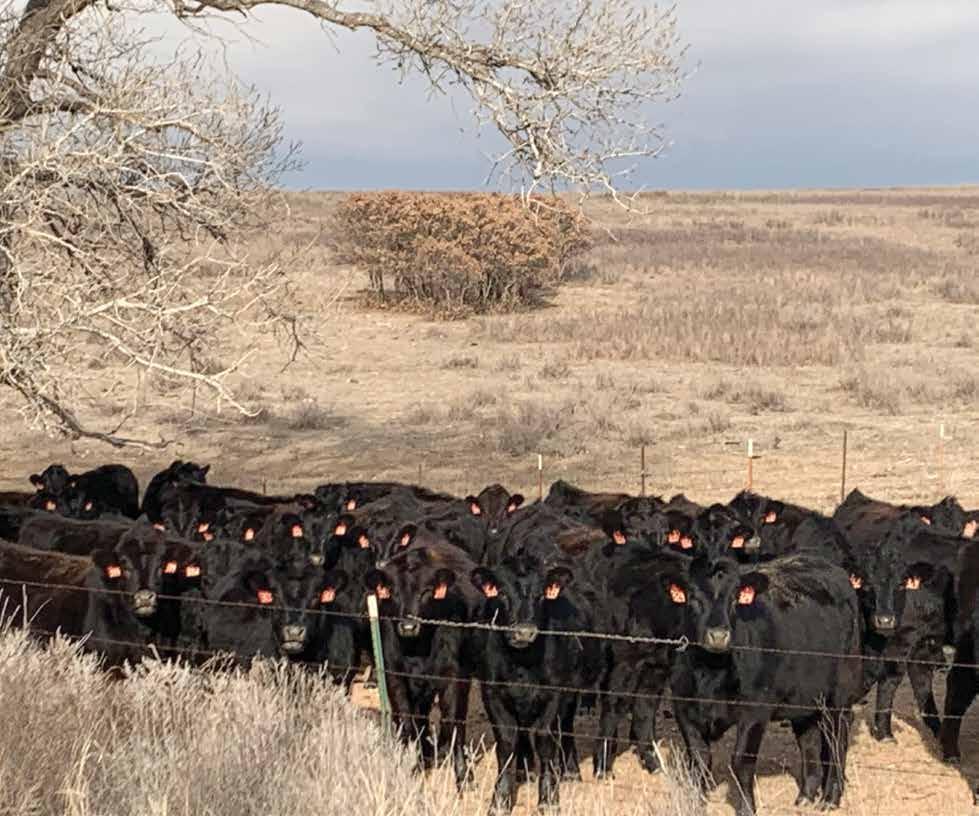
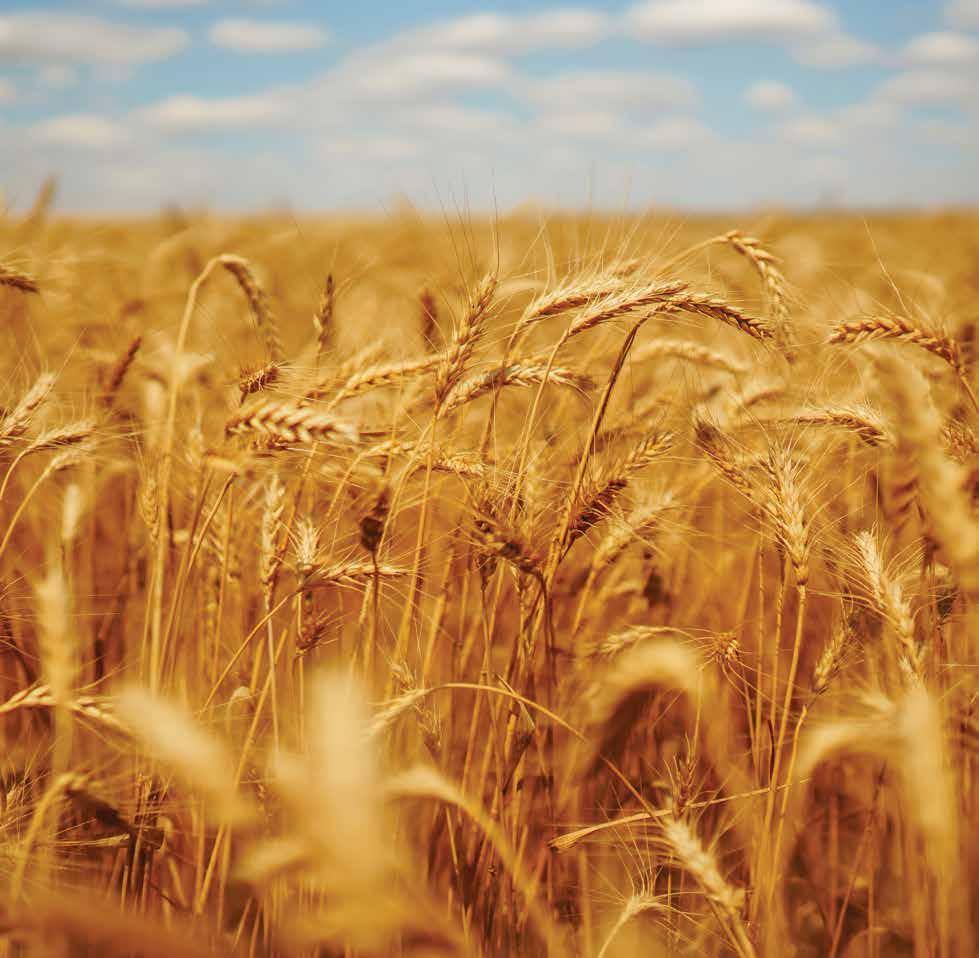
Stock your tanks with proven power and fresh, new options. Let Grassroots Genetics be your partner in building a successful fall breeding program.



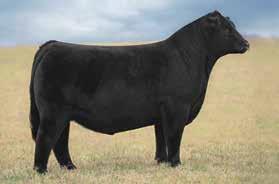
Homo Polled | Homo Black | 70% Lim-Flex
HBRL Gateway 9511G 82F x AHCC Miss Earning Power 917G
BW: -0.6 | WW: 84 | YW: 145 | MK: 34
RE: 0.48 | MB: 0.77 | $TPI: 148
Homo Polled | Red | Purebred
RPY Paynes Cracker 17E x B Bar Nicole 11D
BW: -3.3 | WW: 52 | YW: 83 | MK: 25
RE: 0.84 | MB: -0.26 | $TPI: 99
Homo Polled | Homo Black | Purebred
RUNL Rialto 135R x RUNL Evening Glow 205 E
BW: -0.4 | WW: 92 | YW: 141 | MK: 19
RE: 1.18 | MB: 0.00 | $TPI: 135
Homo Polled | Homo Black | 52% Lim-Flex
MAYC Gold Buckle 624G x WWLU Hottie
BW: -1.1 | WW: 53 | YW: 81 | MK: 22
RE: 0.31 | MARB: 0.27 | $TPI: 82
Grant Hubbard (918)541-4990
Claire Hubbard (765)404-8458
grassrootsgenetics@gmail.com | Follow us on Facebook
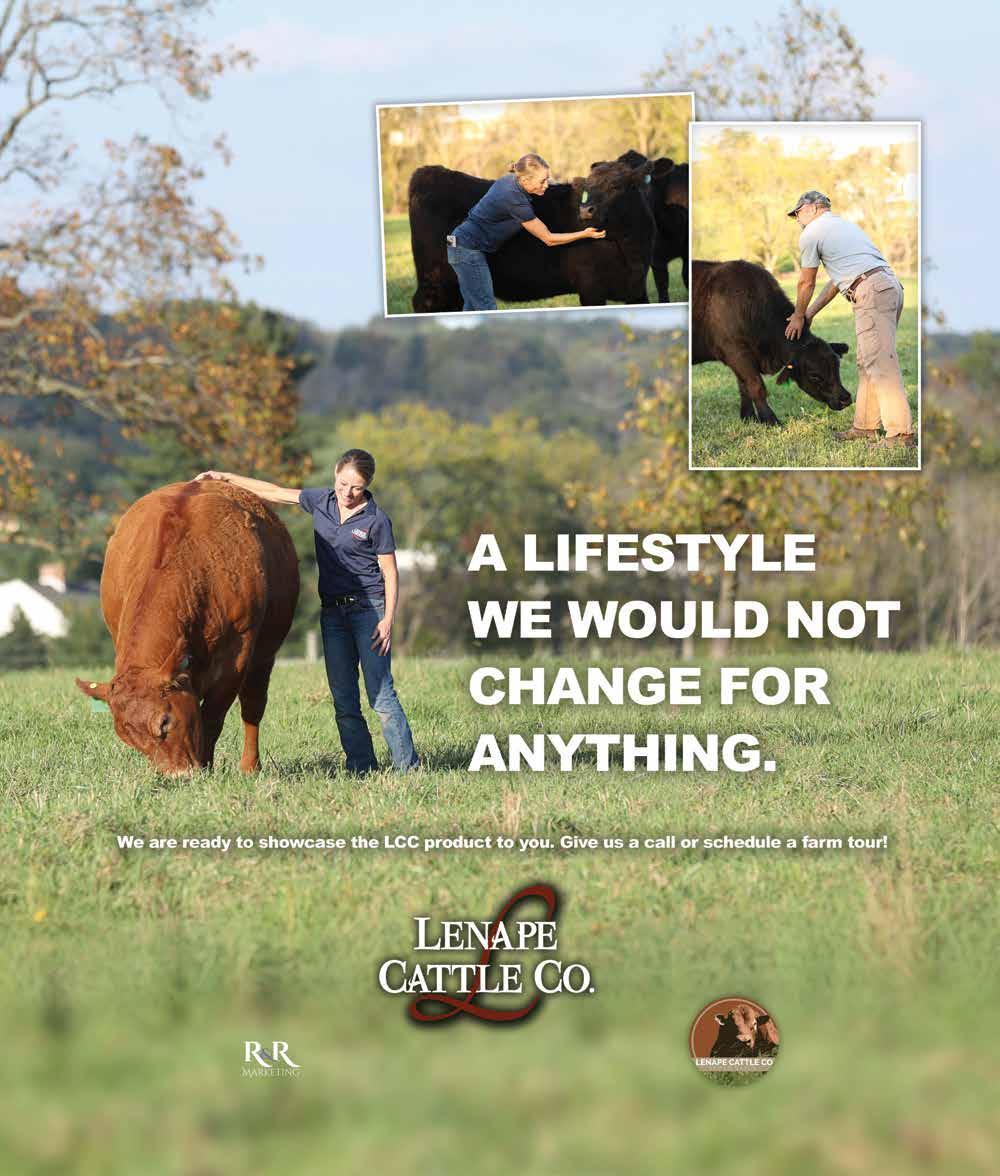

by Mark Anderson Executive Director North American Limousin Foundation
he NALF Board of Directors had a productive meeting this August in Denver. Significant price breaks for DNA testing went into effect as of September 1 for the NALF membership. The NALF board is excited to pass this cost savings on to the membership which greatly reduces testing cost and incentivizes folks to get their cattle genomically-enhanced.
The new lab testing price declines are primarily geared toward the cost of the GGP 100K test which has been reduced by $15/hd to $42 which includes free parentage. If the cattle are tested for the 100K, then the add-ons for testing color, polled and myostatin have all been reduced by approximately 50% to $10 per test. Given the higher cost of standalone testing prices, it makes good sense to get the cattle genomically-enhanced and take advantage of the lower homozygous trait testing as add-ons with the 100K.
DigitalBeef has been the NALF herdbook software provider for our registry system since 2015. Since they were acquired and purchased by 701x last year, the relationship and services provided to NALF members continues to grow and be enhanced. At the August board meeting, 701x announced it will be providing their cattle management software for free which will work seamlessly and fully integrate with the NALF DigitalBeef herdbook.
This means you will be able to access the beef cow management software program from your iPhone, Android, iPad or computer. When out in the field during calving, weaning, etc., you will be able to enter data directly and easily on your phone, which will directly flow into your herds member site for easy data entry for various phenotypes. You can do away with the notepad and the errors that may occur with re-entering data, and it will all drop into your birth queues, etc., for your inspection prior to committing to submitting the data. There will be many features that will be enabled to make your life easier and NALF will be posting instructional videos soon.
You can also expect the look and operation of DigitalBeef to transition to a new look and operating system by the end of Summer 2026. 701x is in the process of writing upgrades to that system while including expanded functionality and ease of use. With technology rapidly accelerating, they are working to enhance the functionality and use of the products they offer to enable cattle producers to save time and labor.
You can also expect to see the additional indexes that were approved for development by the NALF board from four years ago for a maternal and an all-purpose index for Limousin breeders. The indexes have been waiting on the completion of the Mature Cow Weight EPD which is nearly completed by IGS. The indexes will be built on the iGENDEC program similar to the recently released $TPI or Limousin Terminal Profit Index. Once these final indexes are in production with the Mature Cow Weight EPD it should be quite a while before any additional EPDs are produced in your weekly run.
Maybe more important than any of the previously mentioned is a movement and shift in the cattle industry as it looks to potentially update and upgrade the current USDA yield grade system. Technology is gradually being developed that can more accurately measure true carcass red meat yield in combination with an improved USDA yield grade system.
This could provide the ability for packers to incentivize cattle producers to provide and ship cattle that excel in muscle and/or red meat yield. This would be favorable to Limousin breeders in the future. Make no mistake, cattle will still be in demand that have superior quality grade but, providing that critter in a carcass that also has a higher percentage of muscle and superior yield grades is the ultimate goal!
If you can, plan on attending the NALF annual membership meeting at the National Western Stock Show this January in Denver, Coloardo. We have some exciting guest speakers scheduled for the annual meeting that will cover these topics in more detail. Dr. Blake Forraker from Texas Tech University is on the slate who works together with Dr. Dale Worner. Both gentlemen are heavily involved in the push to update the USDA yield grade system and technology to more accurately measure red meat yield. Also slated is 701x who will preview the beef cow management software offered to NALF members in addition to products to help capture real-time data on your cattle.
We look forward to seeing you down the road at NWSS in Denver, Cattlemen’s Congress in OKC or on the road at the fast-approaching 2026 bull sale season!
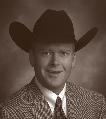
KILEY McKINNA Owner
402.350.3447
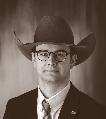
WILEY FANTA Sales & Service Associate
320.287.0751

CLAIRE HUBBARD
Executive Service & Marketing Associate 765.404.8458

Visit our website for a full sale schedule. www.mcmarketingmanagement.com Your Trusted Livestock Brokerage Firm
This fall, our team is hitting the road with breeders and buyers across the country. From coast to coast, in-person or online, we’re proud to manage a lineup of premier sales designed to connect quality cattle with progressive programs. Follow our sale trail and join us along the way.
10/4/25 Bradley Cattle Co. Annual Fall Colors Female Sale, Springfield, MO
10/6/25 HeartBrand Cattle Family Matters Production Sale, Live Ag
10/9/25 Coleman Limousin Discovery Sale of 2025, Charlo, MT
10/11/25 Pembrook Cattle Co. Annual Fall Production Sale, Fairview, OK
10/11/25 Thomas & Sons Halloween Hunnies Online Show Heifer Sale, SC Online Sales
10/12/25 Sullivan Farms Maternal Legends Multi Breed Open Heifer Sale, SC Online Sales
10/13/25 Balamore Farm Ltd & Guests Shoreline All Breeds Female Sale 2025, Great Village, NS
10/13/25 Sullivan Farms Multi Breed Bred Heifer, Donor Cow & Genetics Sale, SC Online Sales
10/14/25 Coleman Angus Annual Female Production Sale, Charlo, MT
10/18/25 Linhart Limousin Fall Harvest Production Sale, Leon, IA
10/19/25 KOLT Cattle Co. Online Female & Genetic Sale, Garland, NE
10/21/25 Wilder’s Aggie Traditions Live Online Sale, DVAuction
10/22/25 Davis Ranches Meet Me at the Backdrop VI Online Sale, SC Online Sales
10/25/25 P Bar S The Social” At Tiny Town Sale, Sand Springs, OK
10/27/25 Buck Ridge Cattle Co. Fall Bull & Female Sale, Seymour, MO
10/30/25 ROM’N Limousin Spooktacular Show Heifer Sale, SC Online Sales
11/1/25 Wilder’s Wagyu Stay Wild ‘25 Sale, Turkey, NC
11/8/25 Edwards Limousin Private Treaty Sale, Higginsville, MO
11/10/25 Edwards Land & Cattle Co. Female and Genetic Online Sale, L365 Auctions
11/13/25 Misty Morning Fall Spectacular Sale, L365 Auctions
12/6/25 Night On The Town All Breeds Sale, Las Vegas, NV
12/8/25 Wagyu and Akashi on the Vegas Strip Sale, Las Vegas, NV
12/11/25 Running R Cattle Co Wagyu Herd Reduction Live Online Sale, Live Ag
12/15/25 Blair’s Ag Cattle Co. Opportunity Knocks Sale, Lanigan, SK, Canada
12/16/25 B Bar Cattle Annual Bull & Female Sale, Lucky Lake, SK, Canada
12/18/25 Glendenning’s J Bar J Holiday Classic Sale, L365 Auctions
SATURDAY, OCTOBER 18, 2025
Linhart Sale Facility • 1 p.m. 19166 270th Ave. • Leon, IA
34 Open Heifers
5 Genetic Opportunities
1 Elite Herd Sire Prospect

SALE TEAM:

KQLL North Star 5004N ET 1/3/25 • 64% Lim-Flex • Het Pld • Homo Blk
S: AUTO Lucky Guy 140D ET
D: CELL Cardi 1403J ET (Charmed)

KQLL Navajo 5002N ET 1/2/25 • 25% Lim-Flex • Homo Pld • Homo Blk
S: PVF Blacklist 7077
D: CELL Cardi 1403J ET (Charmed)
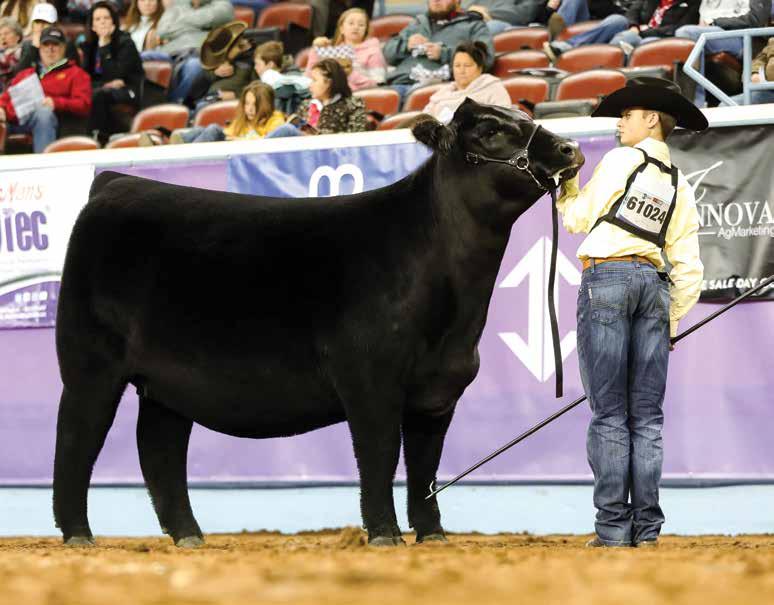
Kiley McKinna 402.350.3447
Wiley Fanta 320.287.0751 mcmarketingsales@aol.com www.mcmarketingmanagement.com

CELL Nashville 5042N ET
2/7/25 • 25% Lim-Flex • Het Pld • Homo Blk
S: Conley No Limit


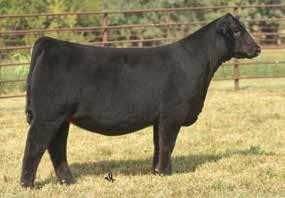
CELL Nora 5003N ET
1/2/25 • 31% Lim-Flex • Homo Pld • Homo Blk
S: STAG Good Times 201 ET
Randy Ratliff 615.330.2735 randy@rrmktg.com www.RRMktg.com
Bill Helton 256.962-0256
D: CELL Cardi 1403J ET (Charmed)


D: AUTO Callie 403D ET (Rebeca 292S)
Charles Linhart 641.340.1306
Aaron Linhart 641.414.5060
Kyle Linhart 641.572.0263 27195 175th St • Leon, Iowa 51044
LINHARTLIMOUSIN.COM
for Thanksgiving and Wednesday, December 24 and Thursday, December 25 for Christmas. The office will be open for regular hours of 7:30 a.m. to 4:00 p.m. MST Monday, December 1, and Friday, December 26.
The DNA turnaround is 4 weeks. Contact Tammy, Tammy@NALF. org, or Alison, Alison@NALF.org, with any DNA questions. Mailed in registrations and transfers are a two-week turnaround, contact Stephanie at Steph@NALF.org with any questions.
2026 - P
2025 - N
2024 - M
2023 - L
Registration is now open for the 2026 Cattle Industry Convention and National Cattleman’s Beef Association Trade Show. The annual convention will be held in Nashville, Tennessee, February 3-5, 2026. Convention participants will hear from industry leaders and gather insight on industry trends. Visit convention.ncba.org for more information.
Each year NALF honors a Commercial Producer of the Year, a Commercial Marketing Booster of the Year and a Limousin Promoter of the Year. These awards are presented at Cattlemen’s Congress in Oklahoma City, Oklahoma. NALF is currently seeking nominations for this year’s awards. Nominations are due by December 1. Nomination forms may be found under the Member Center of the Management tab at NALF.org or may be requested from the NALF office at 303-220-1693 or Limousin@NALF.org.

This year, the NALJA board is selling raffle tickets to win $10,000 cash! The raffle will take place at the 2026 Cattlemen’s Congress and Annual Limousin Convention during the Genetics on Ice Benefit Auction on January 4, 2026 in Oklahoma City, Oklahoma. December 1 is the last day to purchase; Only one ticket will win $10,000.
Contact a Junior Board Member to purchase your ticket today!
3-7, 2026 • OKLAHOMA CITY, OK
Entries open: November 1, 2025
Entry deadline: November 20, 2025
Ownership deadline: December 1, 2025
Late Entry and Substitution deadline: December 5, 2025
JUDGES:
Junior Limousin & Lim-Flex Shows: Mat Lewis, CO
Limousin & Lim-Flex Pen Shows: Jirl Buck, OK
Level I MOE Open Show: Tyler Cates, IN; Associate: Kyle Shoufler, IN
HEADQUARTERS HOTEL:
Embassy Suites by Hilton Will Rogers World Airport 1815 S Meridian Ave, Oklahoma City, OK 73108
Main: 405-682-6000, Fax: 405-682-9252
Rate: $112/room
TENTATIVE SCHEDULE OF EVENTS
Thursday, January 1
Noon Cattle Arrive
Friday, January 2
All Day Cattle Arrive
Saturday, January 3
6:00 p.m. Cattle in Place
Sunday, January 4
9:00 a.m. Junior and Open Show Check-in and Pen Show Check-in
6:00 p.m. Membership Banquet, Ken Holloway Genetics on Ice Auction - Hotel
* CornerPost Raffle Drawing in conjunction with Genetics on Ice Benefit Auction
Tuesday, January 6
8:00 a.m. Junior Lim-Flex & Limousin Shows
2:00 p.m. Limousin & Lim-Flex Pen Shows
Wednesday, January 7
8:00 a.m. National Limousin MOE Show
After Show: Begin Release
10:00 p.m.
All Cattle Out
More information and deadlines will be made available in the coming weeks on the NALF website, Limousin Latest and social media outlets.
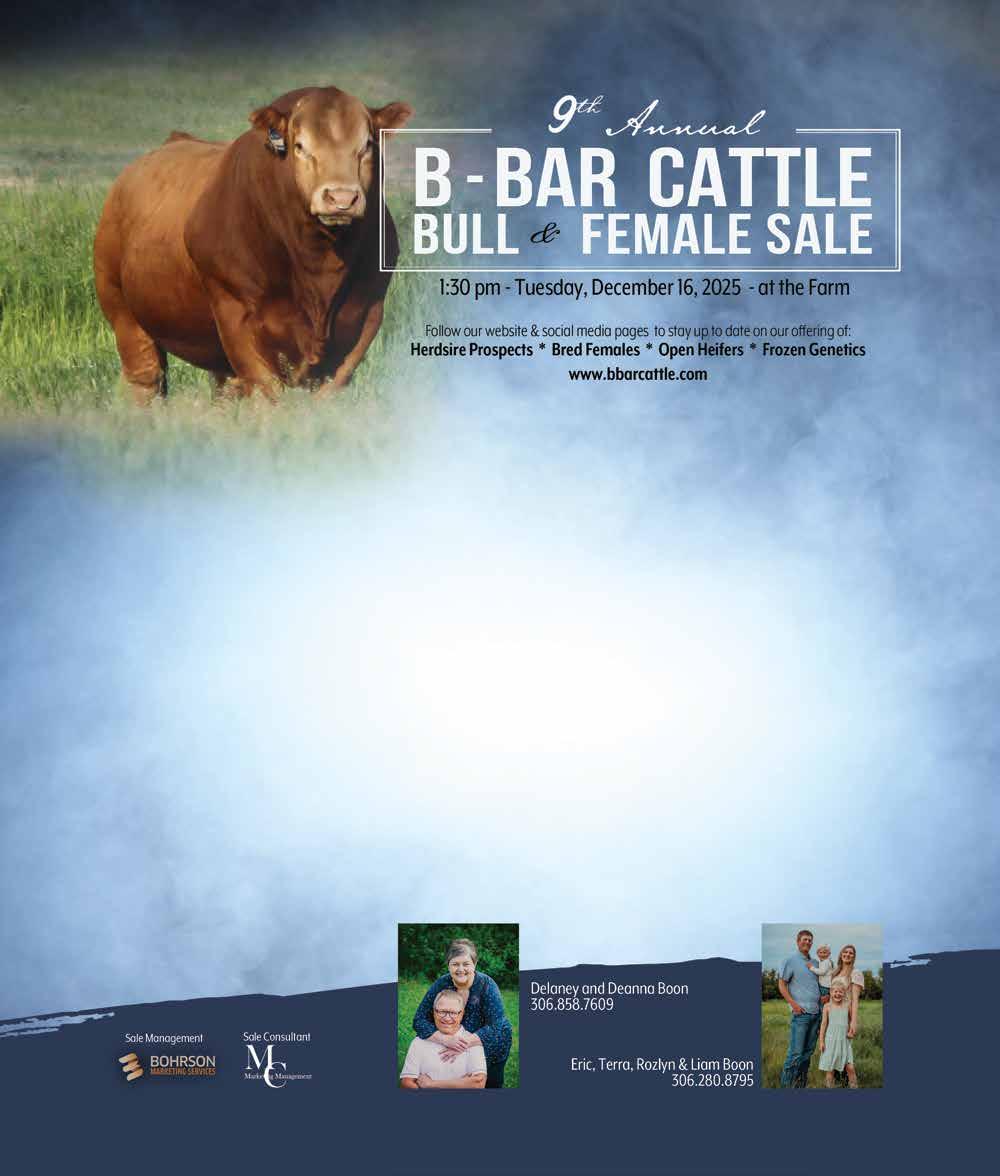


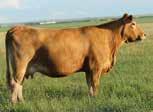

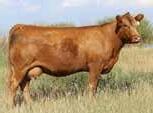
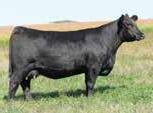



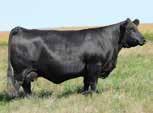




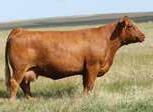
For the last 40 years we have selectively bred our cattle to perform under all conditions. Cows that stay and bulls that pay — we believe this motto to our core. Our program and yours require bulls that get the job done by putting pounds on the ground and cows that are self sufficient and require lower input costs.
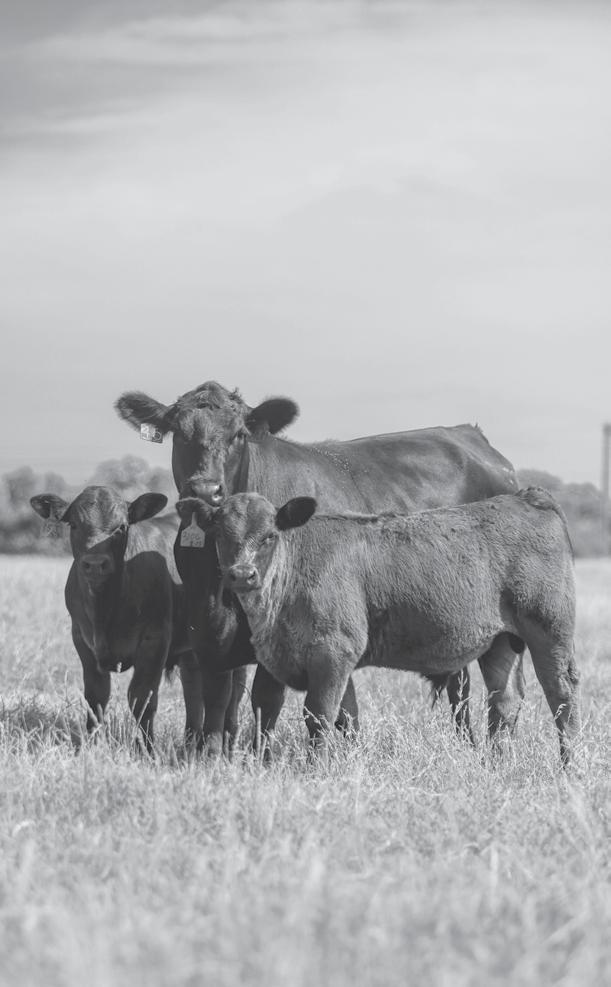
Entry deadline: November 20, 2025
Ownership deadline: December 1, 2025
Late entry deadline: December 20, 2025
JUDGES:
Open Show: Paul Hill, CO
Junior Show: Britney Creamer, CO
Pen Bull Show: Jay Hennessy, ND
HEADQUARTERS HOTEL:
Embassy Suites by Hilton Denver Central Park 4444 North Havana Street, Denver, CO 80239
Main: 303-375-0400
TENTATIVE SCHEDULE OF EVENTS
Wednesday, January 7
Call or stop by the ranch anytime.
We always have a large selection of pasture proven bulls and females available to meet the needs of any size operation.
Judy Bugher, 405/306-1315
Edna Manning, 405/306-1316
JP Owen, 832/525-1153
9700 Slaughterville Rd. • Lexington, OK 73051
Ranch Office: 405/527-7648 • email: hayhooklimousin@gmail.com
All Day Yard Cattle Arrive Hill Cattle Arrive
Friday, January 9
Noon Hill Cattle In Place
10:00 p.m. Yard Cattle In Place
Saturday, January 10
9:00 a.m. Yard Cattle Check-In
2:00 p.m. Hill Cattle Check-In
*NALF Annual Membership Meeting: Sunday, January 11, time TBD
Monday, January 12
8:00 a.m. Junior Show Open Show (following Junior Show)
After Show Hill Cattle Released
Tuesday, January 13
8:00 a.m. All Hill Cattle Out
9:00 a.m. Pen Show After Show Yard Cattle Released
Wednesday, January 14
8:00 a.m. All Yard Cattle Out
Additional information and deadlines will be made available in the coming weeks on the NALF website, Limousin Latest and social media outlets.
These herd sires call home to the Show-Me state and Misty Morning Limousin. They live up to their billing as they represent some of the breeds most proven lineage and performance traits.

added performance and increased profits. proven lineage for greater acceptability. more consistency and more uniform calf crops. strong maternal traits and more longevity.
Let us show you the progeny we have available by these leading sires. Breeding-age bulls and females for sale.
Watch for our consignments at some of the breed’s leading upcoming sales.

PUREBRED & LIM-FLEX “Better Genetics for Bigger Gains”
JAMES D. HERR
17329 S. Nebo Dr. - Versailles, MO 65084 ph: 573/378-0500 - fax: 573/378-5137 - jherr@gvsdis.com www.mistymorninglimousin.com

93% Purebred • Homo Polled • Black CELL Envision 7023E x Miss L7 514C

January 4, 2026 | Embassy Suites | OKLAHOMA CITY, OK
DEADLINE FOR DONATIONS IS DECEMBER 1, 2025







by Randy Ratliff
Unity highlights the importance of working together to achieve a common goal. We know individuals are more effective when they act as a unified team in a collective effort. When we share a common purpose, the interconnectedness of all creates a harmony which fosters a sense of belonging and purpose among team members. These core aspects are the fundamental ideas that ensure nothing is left wanting or divided.
#Unity
-Together, unstoppable
-Cultivating growth
-Driving innovation
-Individually unique, collectively strong
As the Limousin business continues to grow and prosper, we must stay united in support of breeders and their interests across all seedstock— Purebred, Lim-Flex and/or Fullblood. One program’s strengths can pave the way for new ideas, while another’s weakness may highlight where resources or support is needed. We are only as strong as we are willing to work together. Let’s unite for a brighter future!
#unity #bestrong #beone #weareallinittogether













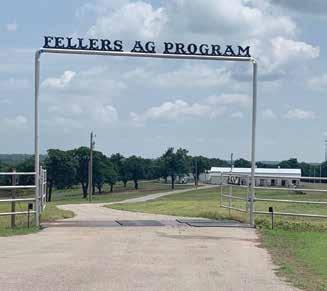
Oklahoma program finds success in and out of the show ring.
by Megan Silveira, managing editor, Angus Journal
Palms a little shaky, Tre Broome gripped his show stick. His left hand was whiteknuckled around the tool, but his right? His right hand was loose and steady on the halter — just what Mr. Black, his steer, needed before walking into the grand drive of a lifetime. Hands are important. They’re what Broome used all summer to work Mr. Black’s hair. Hands are what a team of fitters used to get that same animal ready to compete at a show this summer in Tulsa, Oklahoma.
But they’re more than just a tool to get things done. Broome knows a good set of hands can also offer support. He’s felt it in the “job well done” handshake from one of his mentors, Bo Blakey. It’s even a hand that marked one of Broome’s greatest moments as a showman, when Scott Greiner brought his palm down on Mr. Black’s side, offering the duo the champ slap at the National Junior Angus Show (NJAS) Steer Show. While all of these hands have played a big role in Broome’s life, there’s one encounter that stands out from the rest. The Boys Ranch Town in Edmond, Oklahoma, has been Broome’s home for the last three years, and thanks to Blakey and other ranch staff, Broome’s felt the warm embrace from the hands of God.
Broome stands today as a young man with eternal salvation, a bright smile, big goals for his future and a quiet confidence that resonates with livestock. Before he donned a cowboy hat, however, his life looked a lot different.
He admits he was struggling, getting kicked out of school and unable to find his path even after attending military school.
“I wasn’t really living a godly life, just wasn’t Christlike at all,” Broome explains.
At the ranch, that’s a tale that’s all too familiar.
“As the boys come to the ranch, they come from broken families,” says Blakey, executive director of the program.
Whether it’s financial troubles, drugs or alcohol, the tenants at the Boys Ranch Town come to the organization for reasons beyond their control. To help get them on track, Blakey says staff have two main missions: to share personal and spiritual love, and to empower the boys with skills that will allow them to be productive members of the community once they leave.
Tucked away on 150 aces in Edmond, the Boys Ranch Town was started in 1953 as a part of Oklahoma Baptist Homes for Children. Despite its rich history, if it weren’t for the sign out front, the ranch itself would appear like its own little town.
There’s the hum of a lawn mower in the distance, a few young men manning string trimmers, the echoing buzz of a motor as someone
continued on page 28








continued from page 26
zips by on a John Deere-green Gator™. Among the gentle businesses, there’s always a smile and wave at the ready.
Pavement leads guests in a perfect loop of the program’s facilities. Up front are the cottage-style homes, where boys have their own beds and space to decorate. They live in small groups and have access to entertainment and kitchen facilities in each house.
Beyond the living structures, there’s staff office space, a gymnasium, a community pool, a series of buildings and barns — there’s even a miniature “grocery store” where the houseparents who live with the boys are able to hand select food for the residents in their cottage.
the Boys Ranch Town. “We’ve adopted that same philosophy here at the ranch. The cattle and the agriculture are tools to help raise these boys and teach them about becoming young men and preparing them for life.”
Blakey knows more than most just how transformative the agriculture industry can be.
“I grew up in northern Oklahoma, a small town called Newkirk; and I grew up in a broken home, a broken family,” he explains.
“The cattle and the agriculture are just tools to help raise these boys and teach them about becoming young men and preparing them for life.”
Bo Blakey
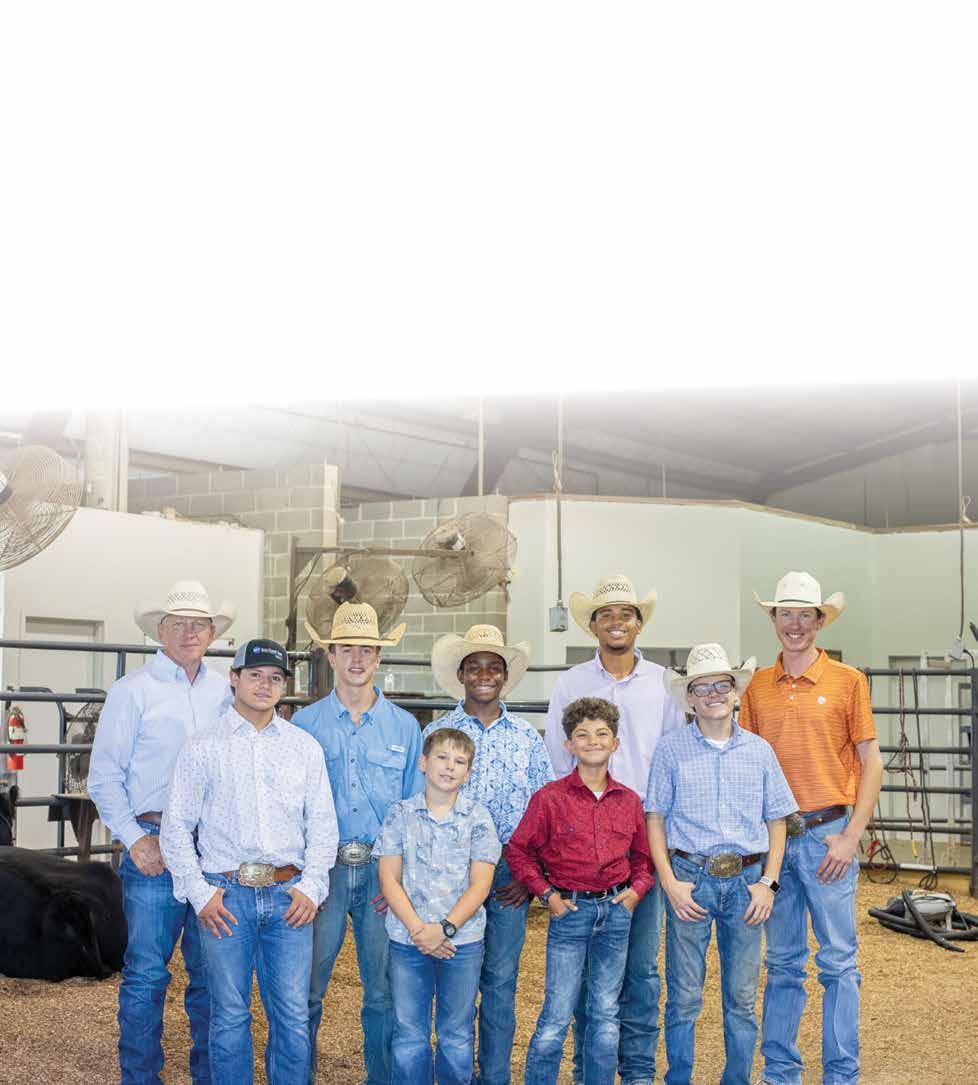
While it’s picturesque, Blakey says the boys are required to be involved with various programs at the ranch — hands-on jobs to help them find their passion and develop a good work ethic. From equine and cattle barns to welding and woodshop, the boys are exposed to a variety of work. While he sees each program as valuable, Blakey’s got a soft spot for the ones directly tied to the agricultural industry. He’s raised three daughters in the business, all of them showing cattle.
“My wife always reminded me that we weren’t raising heifers, we were raising daughters,” Blakey remembers of his time before joining
As a ward of the court, Blakey was raised in a foster home, but one family changed his life for the better. With an ag teacher for a foster parent, he encountered the world of livestock at the age of 16. His past isn’t spotless, but in a bigger way, it’s what makes him so perfect for his role at the Boys Ranch Town.
“I know how long it takes to get that healing, that peace,” Blakey admits.
He’s watched the transformation happen out in their pasture.
“When I got here, I didn’t really want to be on a show program,” Broome admits. “But I saw how it helped people and shaped them to be a better person, because [of] Mr. Blakey and everybody pouring into the show program.”
continued on page 30
Generations of selection have shaped a sire lineup built on quality, consistency and proven results. Semen Available Today – Contact ownership or your preferred semen distributor. Watch for progeny by these sires in our annual bull sale.

WZRK Los Toro 7064L • NXM2604964 Owned with Wulf Cattle.
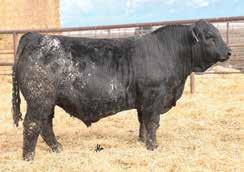
Landslide 25L • NXM2568077

WZRK Liberty Bell 9040L • NPM2605023 Owned with Hager Cattle Co.
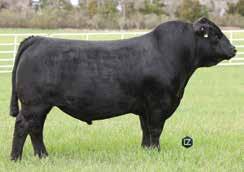
COLE Jackpot 38J • NXM2377369
Owned with Coleman Limousin Ranch and Hager Cattle Co.


CELL TMCK Kickin Up Dust 2261K • LFM2525708

WZRK Kryptonite 5022K • NPM2520652 Owned with Fillmore Ranch.
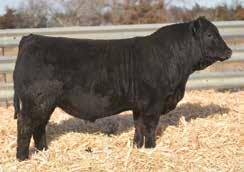
WZRK Mike Drop 8016M • NPM3135881 Owned by Wulf Cattle

Kactus 4841K • NPM2509653

AHCC Landmark 917L • LFM2606215
Owned with Fuchs Limousin and Hager Cattle Co.
Today, he’s come full circle.
“The work that you do, it builds discipline. The people mentor you, make you better. It’s crazy how good [this program is,]” Broome says. Ironically, now it’s hard to keep him out of the show barn.
“I like the environment,” Broome says. “It got me past the obstacles I was going through. When I got here, I got saved. God working in my life made me a better person.”
they’ve come a long, long way,” he says with a soft smile as he watches a crew of about six wash calves. “Overall they do a really good job of working together.”
It’s a fine line, he adds, finding the balance of keeping the boys safe and productive while letting them gain their independence and confidence. Like most stock show kids, age can play a big factor in determining roles in the barn.
“Faith and livestock just go hand in hand. I think that’s why we’re in the ag business.”
Broome is one of 12 boys who share daily chores in the show barn. At any given time, Blakey says there are up to 15 animals they’re caring for. As the show barn manager, it’s been Stratton Walck’s job for the past year and a half to help the boys care for the animals and help prepare for shows. While he was taking on the task of teaching others when he accepted the role, the young cattleman admits he had a lot to learn, too.
“I would say I was a bit lost and just trying to jump around, make things happen and [figure out] what I wanted to do,” he explains. “It’s definitely been a change in my life. It’s helped me out for the better.”
While putting himself in a faith-filled community like Boys Ranch Town has helped Walck connect deeper with the Lord, he says he’s been reminded — alongside the boys — that the cattle business is about camaraderie. “The boys we have here today,
“I really try to push those older kids to be leaders,” Walck explains. Broome was one of those Walck could see had potential.
Bo Blakey
“He really had a gift for it,” Blakey confirms. “He literally has broke most of the animals in our barn, and he’s super patient. He’s worked hard to get to that point, and he’s a good leader and role model for the other boys.” That dedication helped Broome earn the right to first pick of show calves this year.
While Blakey is quick to admit their team isn’t on the mission of breeding steers, it seemed God had different plans when an embryo
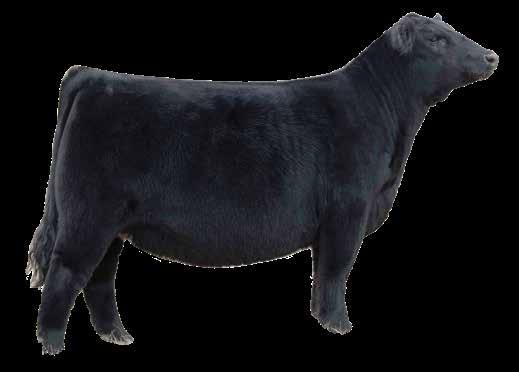

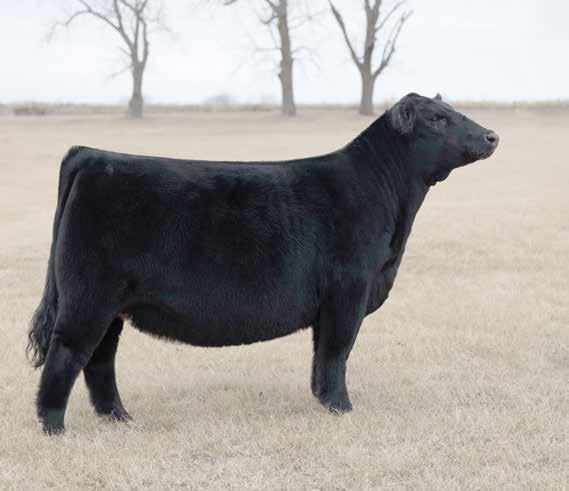
Your opportunity to obtain genetics from Lady and other members of our elite donor stable awaits at these premier events.
LINHART FALL HARVEST SALE October 18, 2025
A NIGHT ON THE TOWN SALE December 6, 2025
CATTLEMEN’S CONGRESS ONLINE SALE January 5, 2026
GREAT AMERICAN PIE SALE April 25, 2026


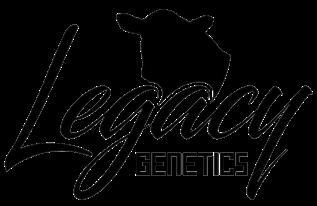
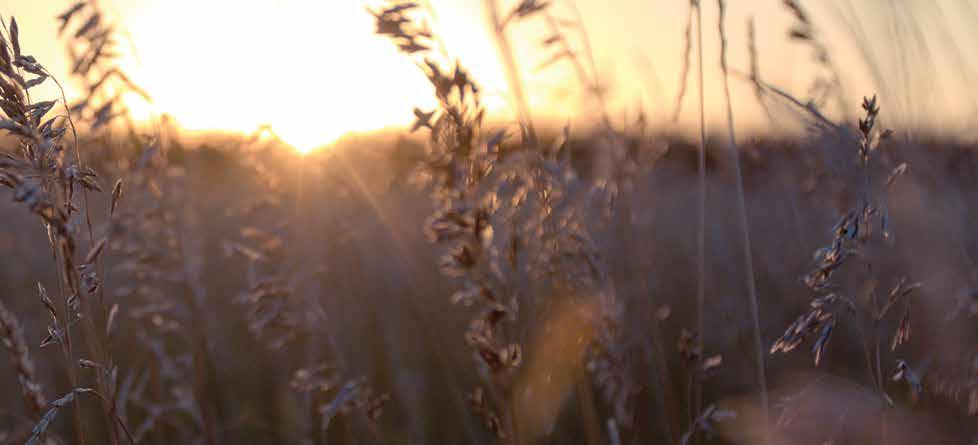

Charles & Nancy Hunt • Dan, Melinda, Jenna, Adeline & Houston Hunt 10329 Hwy. 136 • Oxford, Nebraska 68967
308/991-3373 (Dan) • 308/920-1120 (Charlie) huntlimo@huntlimousin.com WWW.HUNTLIMOUSIN.COM




Part of the appeal to joining the Boys Ranch Town show team, in Bo Blakey’s opinion, is the access to good people in The Business Breed.
“I think in the Angus industry … and especially in the Oklahoma Angus Association, the people who come around our boys and support them at shows is amazing,” he says.
Mark Johnson and Ron Hinrichsen are two names that come to mind easily. Blakey says both have donated cattle to the program and played a significant role in helping their program find show heifers.
From Tre Broome’s eyes, donations and help like this have changed his life.
“I would like to say thank you to all of y’all. I thank you,” he says. “We wouldn’t be here if it wasn’t for y’all.”
While Blakey is always humbled by the support, he’s come to know that love and support are never in short supply in the cattle business.
“Faith and livestock just go hand in hand,” he says. “I think that’s why we’re in the ag business.”
Know someone who needs the help of Boys Ranch Town and Oklahoma Baptist Homes for Children?
www.obhc.org/ministries/placement/ applications-for-child-focused-placement/
Volunteer with the Oklahoma Baptist Homes for Children
www.obhc.org/get-involved/serve/
Make a donation to Boys Ranch Town https://gift.idonate.com/obhc/boys-ranch-town
continued from page 30

Broome, Walck and Blakey all admit they felt a bit like they were floating when it was time for the grand drive.
“I was kind of zoned out,” Broome admits with a laugh, “just hoping and wishing to win.”
When the champ slap came, Broome was excited — not just for himself, but for the entire team at Boys Ranch Town.
“It was amazing,” he says. “It wasn’t just a win for me; it was a win for all of us because we all put in work. It’s amazing having everybody here. I wouldn’t trade any of them for anything, because we just have the chemistry to be able to work together and we just love each other.”
While Blakey could easily pat himself on the back for the breeding decisions he’s helped make, he looks at the purple and gold banner now hanging in the office at the ranch and sees a much bigger picture. “You can’t breed for heifers all the time then all of a sudden have the grand champion steer [at the NJAS] and think that I did it,” Blakey says. “I didn’t. It’s what God has done.”
Reveling in the win and the love of the One who made it possible, Broome’s got big plans for his future. He’s set to attend Oklahoma State University in the next year, where his studies will help him prepare for a future career as an ag teacher. He’s come to realize his story isn’t just a coincidence or a twist of fate.
Every challenging moment of the past was God moving intentionally, ensuring Broome would land in good hands at the Boys Ranch Town. In this tight-knit, faithful community, Broome’s been supported. He’s been grounded, he’s been challenged, he’s been saved. It’s a legacy he’ll be proud to hand off to the next generation.
Editors Note: This article was originally published in the September 2025 issue of the Angus Journal


SCHEDULE OF EVENTS:
SUNDAY, JANUARY 4
9 a.m. Junior and Open Show Check-in and Pen Show Check-in
6 p.m. Membership Banquet, Ken Holloway Genetics on Ice Auction - Hotel * CornerPost Raffle Drawing in conjunction with Genetics on Ice Benefit Auction
MONDAY, JANUARY 5
7 p.m. Online Limousin Sale, hosted by L365Auctions.com
TUESDAY, JANUARY 6
8 a.m. Junior Lim-Flex and Limousin Shows
2 p.m. Limousin and Lim-Flex Pen Show
WEDNESDAY, JANUARY 7
8 a.m. National Limousin MOE Show HOTEL HEADQUARTERS: Embassy Suites by Hilton Will Rogers World Airport 1815 S Meridian Ave, Oklahoma City, OK 73108 405-682-6000
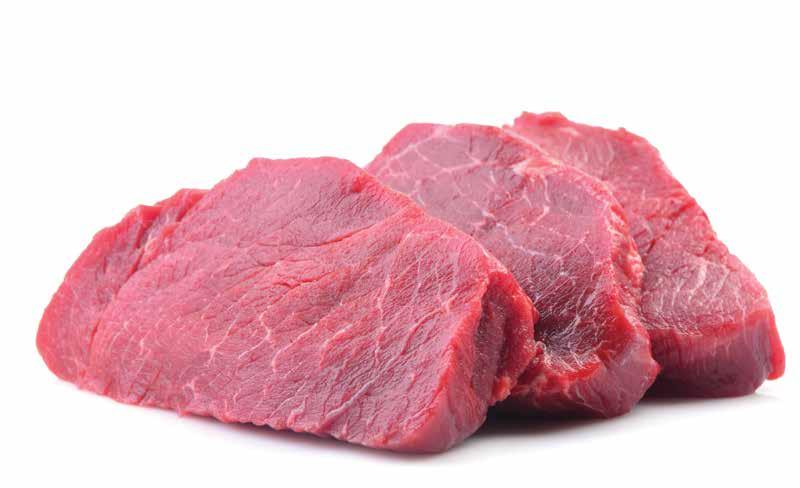
In Beef Buzz, Senior Farm and Ranch Broadcaster Ron Hays spoke with Dr. Dale Woerner of Texas Tech University, who says the beef industry needs better ways to measure red meat yield, because weight alone no longer tells the full story. As he explained, “Red meat yield is important for our industry, because ultimately we’re trying to produce beef. Today, in the cattle population, weight of the animal is just simply not a good enough scale of producing beef. There’s so much variation It relates to efficiency, it relates to profitability, it relates to all of the things that are on top of the mind of the consumer, like greenhouse gasses and carbon.”
He pointed out that new tools, while not brand-new to science, are just now being applied to the beef business. “We’re looking, generically speaking, at X-ray technologies. We’ve looked at a variety of those, where we’ve landed is CT scanning. That’s just a millimeter-by-millimeter or a slice-by-slice look at muscle, fat, and bone within that carcass. And then with computing technology, and artificial intelligence, there’s a lot of additional opportunity with that technology to do a lot of really cool things.”
Momentum is already building. According to Woerner, “National Cattlemen’s Beef Association is gathering leaders within the industry, pulling together the thought leaders. We’re looking at research projects to really further evaluate CT, take a look at the cattle population… in a three to five year time frame, I think we can make some really serious headway.”
One weakness of the current yield system, he stressed, is that it ignores nearly half the carcass. “The yield grade equation is based
on data that was collected from 1958 to 1960, but didn’t take into consideration nearly half of the carcass weight, which goes into hamburger or ground beef. Not only is it 45% of the weight of the carcass, but it’s that much of the value of the carcass to go with it. If we don’t look at that component then we’re just missing half the boat in this discussion.”
He also addressed the pressure to produce bigger cattle at a time of low inventories. “We’re just increasing the size and weight of those cattle to make sure that we’re pushing pounds through the feedlot Problem is that’s not serving us well on the proportion or the percentage of that carcass that’s actually saleable as an edible cut. What we’re working on is correcting that by at least creating a tool… to appropriately incentivize a different animal type, first of all, genetically speaking, with more muscle, but then also sending a clear signal back to cattle feeders to say, hey, we don’t have to feed them this long to get to the desirable levels of marbling or eating quality.”
Dr. Woerner also emphasized that genetics, feedlots, and packers all need better data to make better decisions. “We have to give the genetic side of our equation the data before they can make those breeding decisions This is a mechanism that should greatly improve defining and evaluating the appropriate or the right sized animal for our industry.” While red meat yield is the focus, he cautioned that balance is key: “We can’t just go off on a tangent and seek red meat yield. We have to keep that in context of the other things in the industry that are really, really important, like live cattle traits and marbling.”


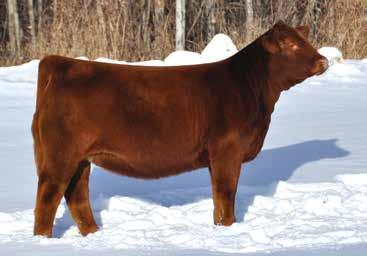

We would like to thank our fellow breeders for the great acceptance of the genetic opportunities we offered in our recent online sale. It is rewarding to see the widespread confidence and interest expressed in our current lineup of donors mated to the best sires in the business. These are the same genetics we are using to build our program around so we are proud you approved.


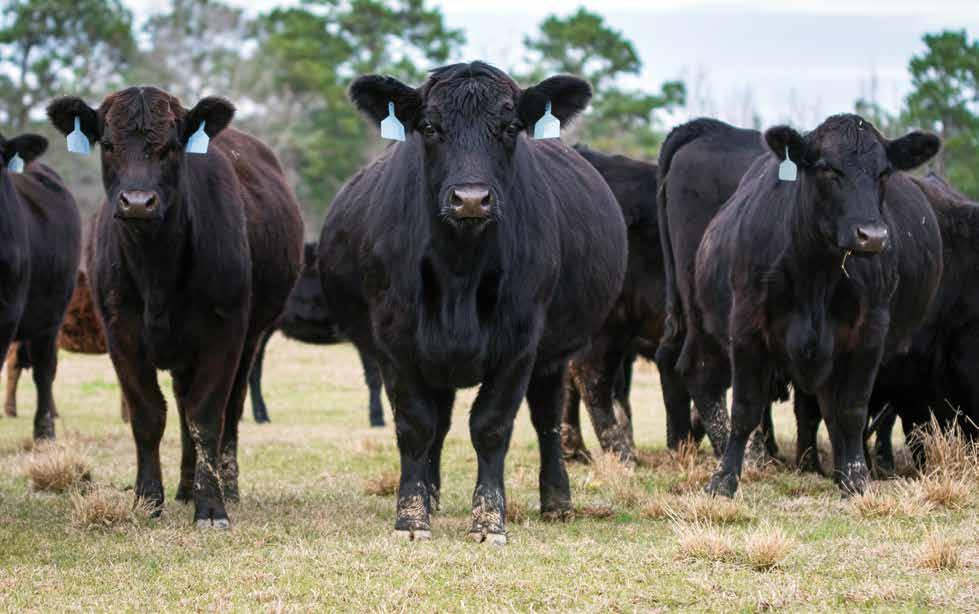
by Aaron Berger Nebraska Extension Educator
The recent sharply higher prices have been a financial benefit for those owning cows. Being able to capitalize on increasing calf prices and to sell a weigh-up cow for more than it costs to develop or purchase has made for excellent times financially for cow-calf producers.
However, the recent increase in price has also drastically increased two hidden, non-cash costs that impact a cow-calf producers’ cost of production. These two costs, which are especially pronounced in today’s current market environment, are depreciation and the opportunity cost of interest on the market value of the cow.
Depreciation is a non-cash expense that producers will not receive an invoice for, but it is a real cost! Unless the rocket like trajectory of the cattle prices continues, which historically seems unlikely, prices will eventually moderate and decline. Even if market prices remain steady, the current price structure for cows
has drastically increased cow depreciation and the opportunity cost of interest on cow value.
To put this in perspective, consider that a $4,000 bred heifer today will become a $2,000 weigh-up cow at current market prices. (If weigh-up prices decline in the future the bred heifer purchased now will be worth even less when she leaves the herd.) If that bred heifer is in production for five years before it leaves the herd, exceeding the industry average, the annual depreciation is $400, excluding any death loss. The cow that dies is fully depreciated as it has zero value when it leaves the herd. Assuming an average cow value of $3,000 over its productive life, with a 2% death loss per year, the annual cost is $60 per cow per year. Cow death loss, plus depreciation, totals $460 per year for each of the five years that the cow is expected to be in production.
Consider also the opportunity cost of interest on the asset value of the cow. For the sake of this example, an interest rate of 6% is used which is midway between what a producer could expect to get in terms of return on investment if the money were placed in a certificate of deposit at 4%, and the cost of borrowing money at 8% to purchase the cow. If opportunity cost is calculated, assuming an average cow value of $3,000 per year at an interest rate of 6%, this is $180 per year.
Combining the $180 of opportunity cost of interest on the average cow market value together with the $460 of cow depreciation, results in a total of $640 per cow per year. If the cows wean on average an 88% calf crop per cow exposed to breeding, this is $727 per calf produced in depreciation and opportunity cost! If the producer receives an average of $420/cwt. for weaned calves with an average calf weight of 525 pounds ($2,205/head), one third of total revenue generated would be needed to cover cow depreciation and opportunity cost.
The cow-calf producer will not get a physical notice for either cow depreciation or the opportunity cost of interest. However, depreciation is the value that is being lost as the cow eventually ages out of the herd, dies and/or as market prices decline. Opportunity cost is the expected return on the capital invested in the cow that could have been generated from an alternative investment.
1. Recognize the different categories of cost economically that are in unit cost of production for a cow-calf enterprise, including both depreciation and opportunity cost of interest on cow value.
2. Understand how increasing cow prices impact the economic cost of producing a pound of weaned calf.
3. Consider ways to get replacement cows into the herd at a lower cost and capture higher prices for cows when they leave the herd to reduce depreciation costs.
4. Recognize that home raised replacements likely don’t cost $4,000 to produce, but this is their market value, and they could be sold to someone else at that price.
5. Evaluate ways to capitalize on cow value. All income from home raised cows held for more than two years are taxed at a capital gains rate when sold. Financially these sales can have significant tax advantages as there is no self-employment tax on this income. Capital gains income is also taxed at a lower rate when compared to ordinary income, such as that from calf or yearling sales.
Cow-calf producers who recognize the economic cost of both cow depreciation and opportunity interest have taken the first step needed to address it. Once a producer sees the significance of these costs, they can then begin to consider what opportunities are available to reduce them.

Needing to reduce some numbers, we have cattle available that have been bred for calving ease, longevity, extra muscle, docility and productivity. We require our heifers to calve at 24 months and our bulls have been developed to go out and work for many years.



by Brooks Johnson, The Minnesota Star Tribune
Typically, when some product becomes too expensive, people buy less of it.
Not so with beef. Despite record high prices for the red meatthanks to a record low number of cattle raised for slaughter - demand for the fresh protein keeps rising.
Folks are more interested in a Jucy Lucy than following the law of supply and demand, it seems. A recent report from CoBank said the “remarkably steady allure of beef, even at current prices” stems from “heightened interest in dietary protein, changing health perceptions surrounding beef and the availability of restaurant-quality beef at retail grocery stores.”
The ag-lending cooperative found beef demand is at the highest level this century even as average fresh beef prices across all cuts have hit a record $8.90 per pound nationally, 9% above prices last summer.
Brian Earnest, CoBank’s lead animal protein economist, wrote budget-conscious grocery shoppers are looking for cheaper cuts or more ground beef instead of the more spendy steaks. But that helped push ground beef prices to a record of $6.25 per pound in July. A pound of ground ran around $3.80 before the pandemic, according to the Bureau of Labor Statistics.
“This consumer pressure on ground beef supply has contributed to tighter availability and interest from other top-producing nations,” Earnest wrote. On the demand side, it’s similar to the high egg prices conundrum: If consumers bought fewer cartons when eggs were hitting records this spring, prices might have come down faster. But the inelasticity - a term for the willingness of consumers to accept price increases for goods they consider necessities - means there might be more records set for beef prices in the months and years to come.
“While larger macroeconomic shifts could influence purchasing behavior in the future, so far, consumers have shown little appetite for sacrificing beef,” according to CoBank.
On the supply side, the U.S. beef herd is at a 75-year low, and slaughter rates are dropping. Imports, especially from Brazil, are incurring higher tariffs.
“Most observers suggest the nation’s cattle supply will remain strained through at least 2026 and likely through 2027,” CoBank’s report found. “That means retail beef prices will remain elevated for the foreseeable future.”
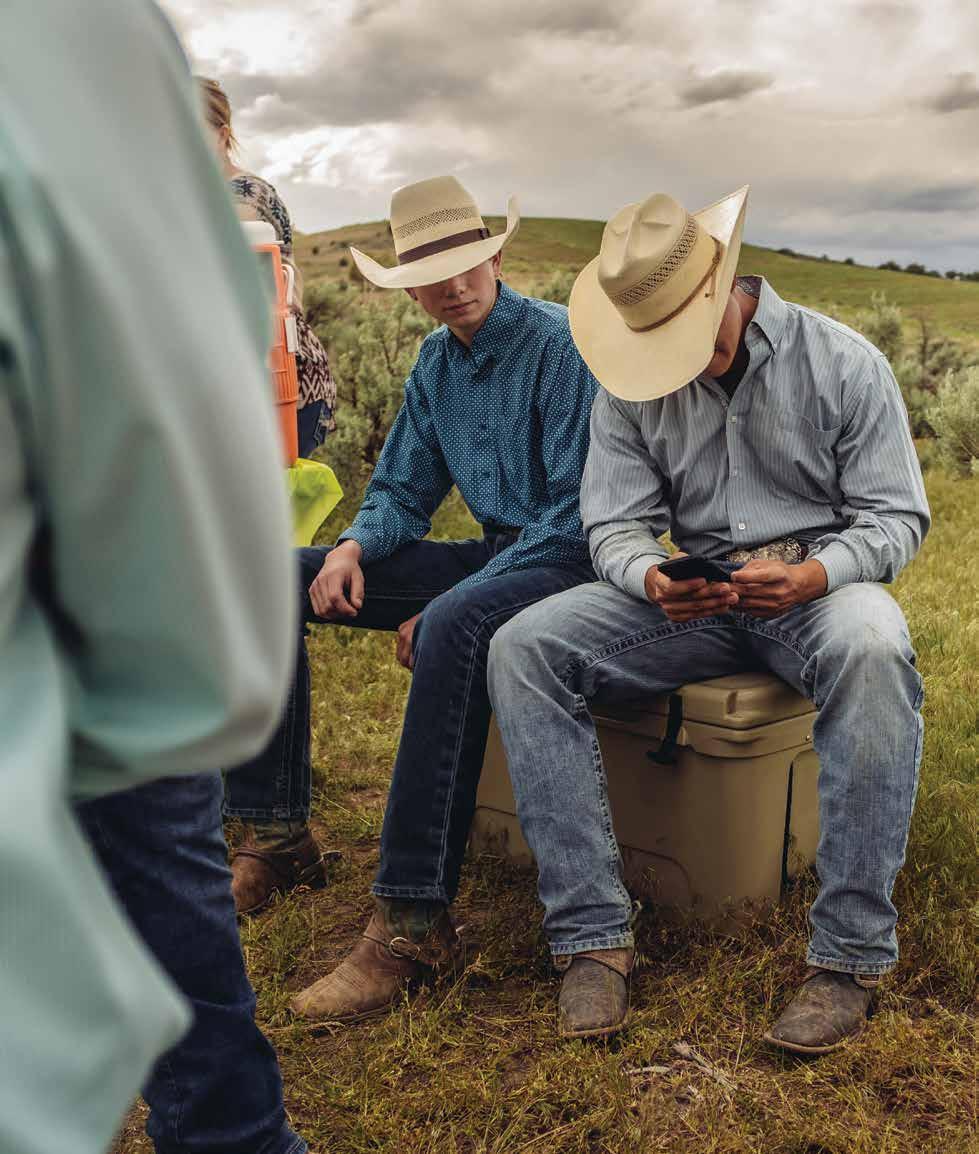
A new way of staying connected is now at your fingertips. Say goodbye to remembering to check sale dates, times and updates. Instead, be notified when a sale opens or nears closing, bidding is extended, videos and catalog are posted and more. Staying updated on all things Limousin related is now in the palm of your hand. Sign up for text alerts today or contact us to see how your marketing efforts can benefit from text alerts.
The concept of regenerative agriculture advocates for practices that should result in “making things better.”
The term “regenerative” has gained popularity in the agricultural community and in food marketing programs over the past few years. The principles behind the regenerative movement reflect many of the recommended practices traditionally associated with the concept of sustainability. Many of these practices have been studied by scientists or practiced by agricultural producers for generations. A report by the California State Board of Food and Agriculture provides a succinct distinction between regenerative agriculture and sustainability efforts.
“The ‘regenerative’ terminology is gaining traction and support like never before due in part to the belief that ‘regenerative’ moves beyond the philosophy of ‘do no harm’ to one of making things better.”
There is not a universally accepted definition of regenerative agriculture. In fact, Newton et al. (2020) reviewed 229 journal articles

and 25 practitioner websites to characterize the term. These authors summarized that most definitions could be classified as process-based, outcome-based or a combination of the two. In their review, most process-based definitions included practices such as more intensive grazing management, reduced tillage, use of cover crops, reduction of fertilizer and herbicide/pesticide use, and integration of livestock and cropping systems. Outcome-based definitions included increases or improvements in biodiversity, carbon sequestration and soil organic carbon composition. Regenerative agriculture is often compared with conventional agriculture, although there is similarly no uniform definition of conventional agriculture.
The U.S. Department of Agriculture’s Natural Resource Conservation Service (NRCS) defines soil health as the “soil’s continued capacity to function as a vital living ecosystem that sustains plants, animals,
and humans.” Efforts to improve soil health are meant to provide additional benefits such as supporting clean air and water, diverse wildlife and beautiful landscapes. In some cases, all these functions can be achieved simultaneously. However, in many cases soils are suited for a subset of these uses. Therefore, it is important to understand the characteristics of each site, its soil type and its condition.
Is there any relationship between soil health, carbon sequestration and carbon footprint for crop and livestock operations?
One method of reducing atmospheric carbon, and thus mitigating global climate change, is to capture and store carbon in soil. This process is referred to as carbon sequestration. Removal of tillage from a crop production system will result in the accumulation of organic carbon in the near-surface soil (0 to 6 inches). In fact, soil carbon becomes more concentrated and stratified (more carbon near the soil surface) with more time under no-till management. Despite the increase in soil carbon in this near-surface depth, there remains a high level of uncertainty about the net carbon sequestration that may occur after transitioning to no-till management. Cai et al (2022) analyzed 144 experiments comparing no-till versus cultivated systems in a review of the literature and found that when sampling depth was increased to two feet, no net sequestration of carbon was observed during 14 years after adoption of no-till. Nicoloso and Rice (2021)
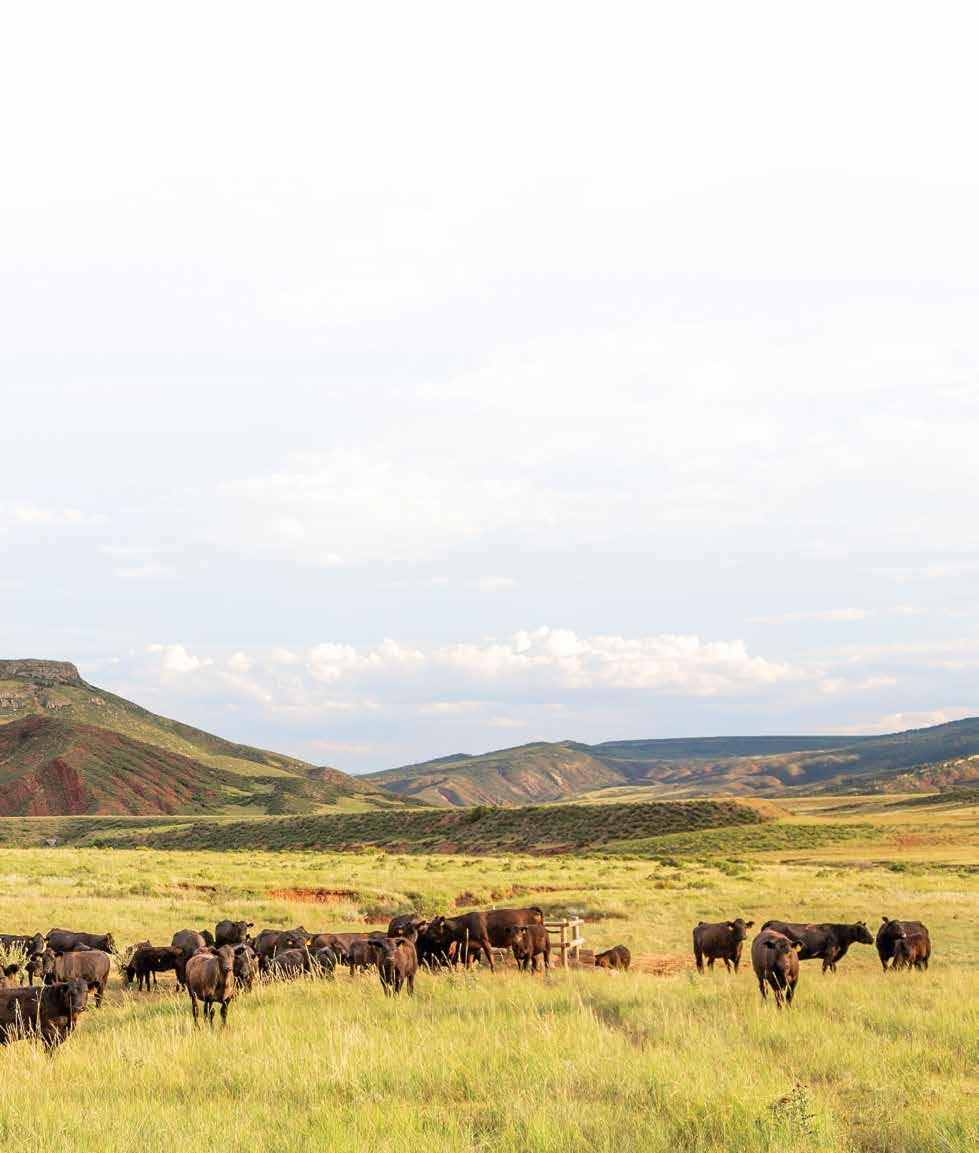
utilized 142 studies comparing no-till and cultivated systems and found similar results when crop frequency was the same. However, when cropping frequency was increased through adoption of double cropping or the addition of cover crops during fallow periods, they did observe significant increases in soil organic carbon. These findings are supported by those of Blonco-Canqui (2022) who analyzed 77 studies evaluating the impact of cover crops on soil organic carbon. In this study, it was concluded that adding high biomass (>1 ton/acre) cover crops to a cropping system resulted in increased soil carbon. Cover crops that did not produce 1 ton/acre of biomass did not significantly increase soil carbon in the top 12 inches of soil. This study concluded that delayed termination to allow for maximum biomass production is an important strategy when carbon sequestration is a goal for the cover crop program.
Sequestration of soil carbon attributed to cover crops is often used to assume that they reduce the carbon footprint of cropping systems. However, this is a simplified understanding of carbon footprints. A carbon footprint must be evaluated using a life cycle analysis. The USDA defines life cycle analysis as a method of assessing the environmental impacts associated with all stages of a product’s life. A life cycle analysis must include all inputs and outputs of a production
continued on page 42
system including raw materials and the processes used to create inputs and deliver outputs to the end user. Therefore, we cannot simply look at the accumulation or organic matter in soils as a net removal of carbon from the atmosphere. We must also consider the carbon footprint of the cover crop seed, its planting and termination in the life cycle analysis as we would the carbon footprint of the manufacturer of the chemicals and tillage operations used in a production system. This is a very complicated analysis, as such; published life cycle analysis available to fully understand the carbon footprint of cover crops versus no cover crop systems is not currently available.
No-till crop production seems to be another practice associated with regenerative agriculture. Is this practice sustainable, profitable and climate friendly?
No-till crop production dramatically reduces soil erosion in most systems. Currently, no-till management is applied to about 37% of cropland throughout the U.S. Economic benefits stem from reduced labor and fuel costs when combined with diversification of crop rotation. The climate benefits are thought to result primarily from the expected soil carbon sequestration resulting from no-till and reduced fuel requirements for no-till. However, lifecycle analyses of no-till versus conventional cropping systems are required to fully understand the climate benefits on a holistic basis. The removal from tillage does reduce fuel consumption, however some of this benefit is offset by the carbon footprint of pesticides and herbicides used in no-till systems.
Several elements of regenerative practices may affect agricultural water availability and quality. It is well documented that keeping the soil covered and minimizing soil disturbance (both key elements of regenerative ag practices) reduce erosion and the runoff of sediment and nutrient-laden water to nearby bodies of water. Furthermore, some researchers have also found that farming systems that maintain a permanent soil cover, minimize soil disturbance and diversify crop/plant cover can increase soil water storage through better soil aggregation and improved soil structure. However, the impact of regenerative practices on soil water retention and water quality varies. Some of these factors include soil texture, preexisting soil carbon and climatic conditions.
Soil moisture availability is very much dependent on the rainfall pattern experienced by each system and the surface residue that would be available without the cover crop included in the rotation. Therefore, the impact of cover crops on soil moisture dynamics for the next crop is highly variable. Cover crops transpire soil water while they are growing. The larger they grow (more biomass) and the longer they grow, the more soil water they will consume. However, the residue they leave behind protects the soil surface from crusting and thereby increases infiltration of subsequent rainfall. Increased dryness after cover crop growth also contributes to the increased infiltration.
In production environments where adequate rainfall is received after termination, soil moisture can be similar or even greater in cover crop treatments. Research conducted in semi-arid climates like those in western Oklahoma has shown that cover crops can increase the collection and storage of moisture after termination, but that moisture availability at planting of the cash crop can still be lower in the cover crop treatment when compared to a fallow treatment.
Oklahoma (as do most states) has a high diversity of growing environments due to precipitation gradients from east to west. In addition, extreme variability in year-to-year rainfall patterns within a region adds to the uncertainty of the influence of cover crops on soil moisture that will be available for the cash crop. Therefore, it is difficult to consistently predict the impact of cover crops on soil water availability for the following crop. We can only say for sure that the greatest likelihood of benefit will be experienced in systems with low residue conditions where sufficient cover crop biomass can be grown quickly and terminated before planting the cash crop to allow for some recharge of the soil moisture.
Adaptive Grazing Management is key to regenerative agriculture. Adaptive grazing management is a process-base management approach where livestock producers make management decisions to achieve specific goals. Monitoring pastures and animals is essential since landowners make management changes when goals are not met. The full process includes:
• Set specific goals for your land and livestock.
• Plan strategically by taking into consideration your resources, skills and labor.
• Monitor resources for specific thresholds.
• Act when thresholds are met.
• Evaluate whether current management practices are meeting established goals.
• Adjust your plan or goals as needed.
Many different types of grazing management strategies fall under adaptive grazing management. What is consistent between them is that managers are regularly reevaluating whether their management is achieving the goals they have set. The management decision that often is the greatest impact on grazing land sustainability, livestock performance and economic sustainability is stocking livestock according to the productivity of the land.
Intensive grazing is also a broad term used for many different grazing systems. What is consistent between these systems is that managers divide pastures into multiple paddocks and while livestock graze certain paddocks, other paddocks are withheld from grazing for a rest period. The number of paddocks and herd density (number of animals per unit of area) can vary between approaches but in all methods, managers rotate herds from one paddock to the next repeatedly. Strip grazing, limit grazing, mob grazing and rotational grazing are all types of management intensive grazing systems.
continued on page 44
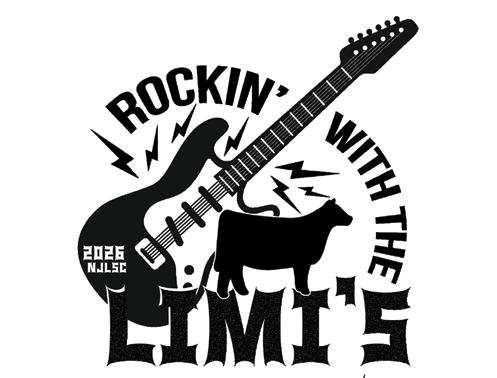
Adaptive multi-paddock (AMP) grazing is a short-duration rotational grazing system where animals graze in dense herds. This approach typically involves grazing each paddock for hours to days until livestock have consumed no more than about 50% of available forage. The manager then rests paddocks from grazing for sufficient time to allow vegetation regrowth. The grazing and rest duration as well as stocking rate is adapted to the rate of vegetation growth as it changes throughout the year and between years. Managers are also advised to avoid using herbicides, pesticides and fertilizers.
Adaptive management is key to sustainable grazing management with benefits to plants, animals and long-term profitability. Some research has compared adaptive rotational grazing practices to nonadaptive continuous grazing, and it is difficult to know whether the adaptive management or the rotational grazing is contributing to grazing outcomes. Research comparisons between adaptive multipaddock rotational grazing and continuous grazing in the Southern Great Plains are prevalent.
A recent eight-year study examined the effects of continuous grazing and adaptive multi-paddock rotational grazing on soil carbon, nitrogen, microbial biomass, soil respiration and biological activity. Rotational pastures were divided into 10 paddocks with cattle moved as one herd to create greater stock density in the rotational pastures versus the continuously grazed, undivided
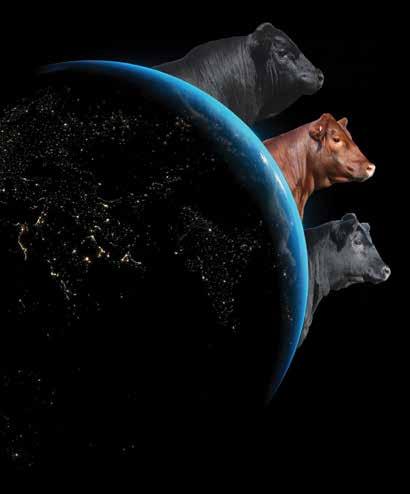
pastures. No differences were found between the two grazing methods for total soil nitrogen, carbon or particulate organic carbon at any depth (0-12 inches) or for soil microbial biomass, basal soil respiration or soil biological activity in the study. They concluded both grazing management strategies preserved important soil properties, and variability within paddocks was much greater than the differences found between grazing systems. This is consistent with other research where variability in rangeland pastures has made it difficult to find consistent results from grazing treatments.
A study by the Noble Research Institute also examined impacts of stocking densities on soil over 10 years. Researchers examined three levels of stocking density and its impacts on soil bulk density, soil resistance to penetration and water infiltration rate. The three levels of stocking density were five yearling stockers per acre for 36-48 hours (light), 10 stockers per acre for 24 hours (moderate) and 20 stockers per acre for 12 hours (high). Stockers grazed paddocks four to six times from April through October with rest periods ranging from 35 to 60 days. The researchers found that greater stock densities increased soil bulk density and resistance to penetration while decreasing water infiltration rates. They concluded that this could lead to “… an increase in surface runoff and erosion. Ultimately, this can lead to the loss of pasture acreage by soil surface degradation and economic decline by the resulting loss of forage production.”
A five-year study compared continuously grazed and adaptive multipaddock rotationally grazed pastures at varying stocking rates. Cattle herds of 10-22 animals were grazed on 4-8 acre paddocks for 2-5 days in rotational pastures. Production of all major forage components (little bluestem, big bluestem, indiangrass, switchgrass, sideoats grama, tall dropseed, bermudagrass, annual grasses and broadleaf plants) were similar between adaptive multi-paddock and continuously grazed pastures at similar stocking rates. Greater stock densities did not increase forage grass production. Under high stocking rates big bluestem, indiangrass, switchgrass, and midgrasses all declined regardless of grazing system or stock density. Another study on adaptive multi-paddock rotational grazing with eight-paddock rotation compared how repeated cattle grazing with varying rest and grazing periods affected vegetation. Adaptive grazing periods ranged from 3-13 days and rest periods from 21-91 days. Total production and pasture composition of big bluestem, little bluestem, indiangrass, switchgrass and other grasses were unaffected by varying grazing cycles. Paddocks with quicker rotations had a greater proportion of broadleaves, primarily western ragweed. Stocking rate, not grazing or rest duration, had the greatest impact with heavily stocked pastures producing 460 lbs. less per acre than lightly stocked pastures.
A study compared livestock performance of yearlings grazing continuously versus those in adaptive multi-paddock rotational grazing. Managers kept yearlings in rotational treatments in a single herd to maximize stock density. Managers adjusted grazing and rest periods to match forage growth. Researchers tracked gain per animal, gain per acre and net return per acre. Over the five-year study, they found individual season-long yearling gains were 29-48 pounds less under
adaptive multi-paddock rotational grazing than for yearlings grazing continuously. Individual yearling gains were 11%–20% lower in adaptive multi-paddock rotational pastures than continuously grazed pastures with the greatest reductions seen in heavily stocked rotational pastures.
Steer diets and forage standing crop measurements indicate these lower gains were due to lower forage intake in rotational yearlings. Forage crude protein in the rotational yearling diets was lower (7.7%) than for continuous steers (9%), likely due to rotating to more mature grass stands rather than continuing to graze in the same pasture. Gains per acre were greater for continuously grazed than rotationally grazed pastures at all stocking rates. Even at the heavier stocking rate, where gains per acre should be maximized, continuously grazed yearlings gained 252 pounds per acre versus adaptive multi-paddock rotationally grazed yearlings 202 pounds/acre over the 150-day grazing season. They found that under no stocking rate would rotational stocking provide the net returns equal to those attained with continuous stocking at a conservative stocking rate. Variable cost per head in rotational pastures would have to decrease by 24%–34% to equalize net returns. This was with no additional fencing or water development cost included. They concluded that unless the decline in weight gain could be reduced, there is no economic incentive for rotational grazing under these conditions.
The responses to grazing management may change with different forage systems and management systems. Research with beef cows grazing an introduced warm-season perennial bermudagrass forage base compared performance and economics of continuous grazing at a moderate stocking rate versus rotational grazing at a similar stocking rate or a high stocking rate of twice the moderate stocking rate. The research was also designed to allow for integration of other forage management activities where possible in the rotational grazing management system, including stockpiling of warm-season grasses and interseeding of cool-season annuals.
All pastures were fertilized according to soil tests to stimulate forage growth at appropriate times for higher forage needs. This research indicated that integration of rotational grazing management resulted in decreased weaning weights per calf by 22 pounds at the moderate stocking rate and by 40 pounds at the high stocking rate. Increasing stocking rate with rotational grazing increased total calf weaning weight per acre by 89% compared to either moderate stocking rate with rotational or conventional grazing management. The total number of days of hay feeding were 106 for the conventional grazing management compared with 37 days for the high stocking rate rotational grazing and 15 days for the moderate stocking rate rotational grazing. Pregnancy percentage and calving rates were not affected by grazing management.
In this analysis, net return per acre was similar for continuous and rotational grazing at the moderate stocking rate, indicating the costs of increased management in the rotational system offset the cost of longer hay feeding season for the continuous grazing system. Net returns per animal were greater for the rotational grazing system with increased stocking rates by reducing winter feeding requirements and increasing carrying capacity. This study underlines the need for continued on page 46
Make plans to join us for our New Year’s Resolution Sale. We are offering 40 carefully selected lots representing the depth, consistency and progressive vision of the ATAK program.












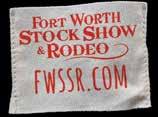




continued from page 45
producers to have a clear objective for their grazing management system and to carefully evaluate research based on those objectives.
Does cattle breeding and selection have a role in regenerative agriculture?
Cattle are a critical component of a sustainable and secure food production system. Most of the beef production cycle occurs on land not suitable for raising crops. For perspective, of the 2.3 billion acres available in the U.S., about 655 million acres (29%) are classified as grassland pasture and rangeland, and 316 million acres (14%) are identified as parks and wildlife areas, some of which are grazed. Beef is a highly digestible and nutrient-dense protein source for humans. Human beings lack the digestive system needed to survive on soil or fibrous plants. Grazing cattle, equipped with a ruminant digestive system, function as an intermediary, turning sunlight, carbon dioxide and water into a nutritious, delicious and sustainable food source.
Beef cattle selection and breeding systems that result in sustainable, economical improvements in land resource utilization are critical to improving ranch profitability, food security and beef production’s carbon footprint. For example, using a planned crossbreeding system results in direct and maternal heterosis in the cow herd. This heterosis (hybrid vigor) is achieved through non-additive genetic effects gained by crossing purebred parents. Maternal heterosis increases reproductive efficiency and cow longevity. Thus, when a planned crossbreeding system is implemented, pounds of calf weaned per cow exposed (to breeding) increases. This improvement in productivity per cow is produced with little to no additional feed or forage inputs. In one classical experiment, crossbred cows produced 30% more cumulative calf weaning weight (511 pounds) in a 12-year period compared to purebred Hereford, Angus or Shorthorn cows.
Better purebred seedstock produce better crossbred animals. Modern genetic prediction offers several genetic values, which can be used to improve the efficiency, sustainability and profitability of beef production. For example, selection pressure to achieve a cow herd with less mature weight, more direct weaning growth, increased reproductive efficiency and moderate maternal milk should result in a cow herd requiring fewer inputs while remaining highly productive.
To date, there has been no standard definition adopted for the regenerative agriculture movement therefore, interpretation of the term continues to vary widely. Definitions can generally be classified as process-based, outcomebased or a combination of the two. The idea of sustainable agriculture was largely seen as an effort to “do no harm” while the concept of regenerative agriculture advocates for practices that should result in “making things better.” Most programs or researchers advocate for practices that result in improved soil health and reducing or minimizing the use of synthetic fertilizer, herbicide and pesticides. While improved soil health is broadly accepted as an outcome of regenerative agriculture, soil characteristics vary drastically from site to site. At the same time, regional climate varies dramatically. For these reasons, practices intended to “regenerate” agriculture at a given site must be carefully evaluated.
Source: OSU Ag Extension



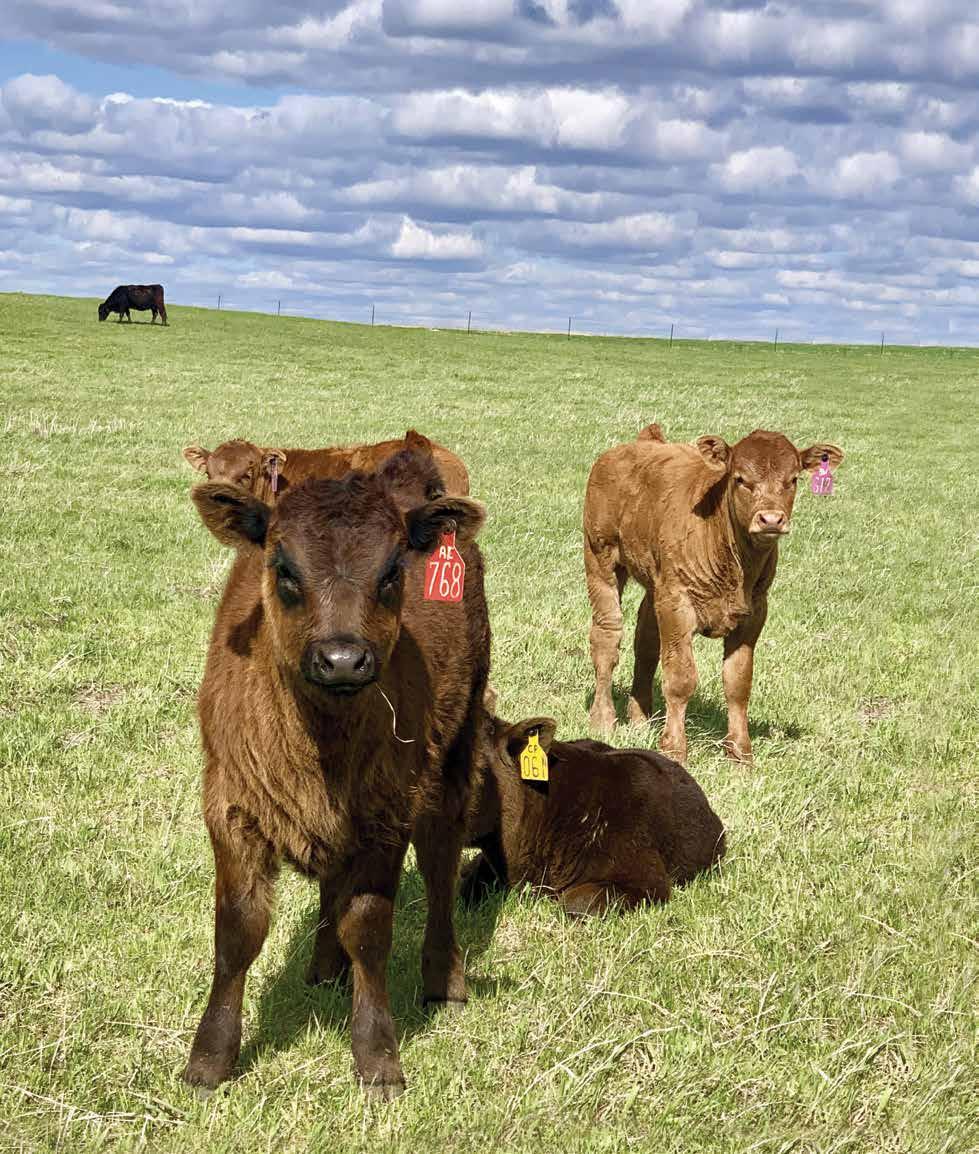
by Lucas Melo-Goncalves and Pedro Fontes Department of Animal and Dairy Science University of Georgia
In cow-calf operations, reproductive success is the primary driver of productivity. Each cow must produce a healthy calf every year to keep the herd economically sustainable. Most producers are familiar with the challenge of cows that fail to conceive, but fewer recognize the long-term effects of pregnancy losses that occur after a cow has already become pregnant. Most pregnancy loss in cattle occurs in the first three months of pregnancy. The term early embryonic mortality (EEM) is used to describe pregnancy loss that occurs within 30 days after conception. These losses are unfortunately common, affecting approximately 20 to 40% of pregnancies in beef herds. While undesirable, these early pregnancy losses are often manageable because cows experiencing EEM often have enough time to rebreed during a typical 60- to 90-day breeding season. Pregnancy losses that occur later in the first trimester of pregnancy, between 30 and 90 days after conception, are referred to late embryonic mortality (LEM). Although less frequent, affecting approximately 3-8% of pregnancies, these later losses can have lasting consequences for cow productivity and herd performance. Causes of later pregnancy loss can include reproductive diseases, handling stress, nutritional challenges, and other health issues that disrupt normal development. This article will provide an overview of a recent research study that evaluated how LEM impacts cow productivity commercial cow-calf operations.
Late embryonic mortality can reduce herd efficiency and cause long-term consequences to cow performance. To better understand the impact of LEM, our group conducted a large-scale study to characterize the production consequences of these losses. A total of 2,204 beef cows from six locations across Georgia, Mississippi, Tennessee and Virginia were enrolled in this study. All cows were bred using a fixed-time artificial insemination (FTAI) program and then exposed to cleanup bulls for the remainder of the breeding season, which ranged from 67 to 86 days total.
1. Maintained pregnancy: cows that conceived to FTAI and carried that pregnancy until the final pregnancy diagnosis.
2. Non-pregnant: cows that did not conceive to FTAI. Some of these cows never became pregnant, while others conceived within the breeding season to the cleanup bull.
3. Late embryonic mortality: cows that conceived to FTAI but lost that pregnancy sometime between one and three months of gestation. Like the non-pregnant group, some of these cows failed to produce a calf, while others conceived within the breeding season to the cleanup bull.
Cows were monitored through calving and weaning and followed them again into the next breeding season to understand both shortand long-term impacts of LEM.
Cows that experienced LEM had decreased (P < 0.01) final pregnancy rates, calving rates and weaning rates compared with both cows that maintained their FTAI pregnancy and cows that were nonpregnant to FTAI. In the subsequent year, cows that experienced LEM calved later and weaned lighter calves compared with both cows that maintained pregnancy and non-pregnant cows. Furthermore, both non-pregnant and LEM cows had decreased pregnancy rates to FTAI and final pregnancy rates in the following year compared with cows that maintained their FTAI pregnancy
Cow productivity decreased substantially in cows that experienced LEM. Both cows that maintained their FTAI pregnancy and those that failed to conceive performed considerably better than cows that experienced LEM. This occurred predominantly because only approximately 40% of LEM cows calved in the subsequent calving season. Among the cows that did rebreed after losing their FTAI pregnancy, a large proportion of them became pregnant later in the breeding season. Consequently, more than 70% of these cows calved in the second half of the calving season. Later calving resulted in younger calves and lighter calves at weaning. In fact, calves from LEM cows were 64 pounds lighter at weaning compared with calves from cows that failed to conceived to FTAI and 125 pounds lighter compared with calves from cows that maintained their FTAI pregnancy.
The effects of LEM carried over into the next breeding season. Because LEM cows calved later, they had less time to recover before the next breeding season, they were less likely to conceive to FTAI the following year. This effect highlights that LEM is not just a problem within the breeding season in which cows experience pregnancy loss, but also negatively impacts productivity in the subsequent year.
Our findings indicate that cows experiencing LEM had decreased performance not only compared with cows that conceived and maintained their FTAI pregnancy, but also compared with cows that failed to conceive to FTAI. Cows experiencing LEM produced fewer calves, calved later in the calving season, and weaned lighter calves. Based on the current USDA Georgia Livestock Report, assuming feeder calf prices of $3.29/pound, cows that experienced LEM resulted in a loss of approximately $963.80 per cow exposed compared with cows that maintained their FTAI pregnancy and $587.30 per cow compared with cows that failed to conceive to FTAI. These differences highlight the importance of minimizing pregnancy loss to maintain herd profitability.
by Jessica L. Sperber Nebraska Extension Feedlot Specialist
As we enter the feedlot fall run, and cattle are newly received into the feedlot, there are key considerations to keep in mind to achieve best cattle performance. The goal of a receiving strategy is to make the transition from calf origin into the feedlot or backgrounding yard as seamless as possible. The first 14 days upon feedlot arrival are critical in calf development and set the performance trajectory of the calf for the remainder of the feeding period. The main goal at receiving is to help with any bovine respiratory disease (BRD) concerns and improve upon the health of the calf.
Get cattle to consume feed and to drink water. Offer calves familiar feedstuffs in the first seven days to “bunk break” cattle. This includes:
• Long-stem grass hay. High quality forages are essential to get adequate energy into the animal while their intakes are depressed.
• A natural protein source that is adequate in rumen undegradable protein (RUP) content to support calf protein requirements. The most likely source (and presumably cheapest) is distillers’ grains, which are approximately 30% protein, with 65% of that protein as RUP. RUP is required most in rapidly gaining, young animals.
• Target 16-18” of bunk space per head.

Low intakes on newly received calves are common and generally improve in the weeks following receiving. In week one, cattle will
continued on page 52

The Heartland Limousin Association welcomes all Limousin enthusiasts. The HLA is passionate about promoting Limousin genetics, honoring commercial producers and encouraging youth with their Limousin projects.
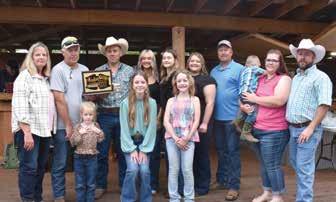


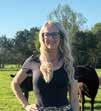


Who can join? Any reputable supporter of Limousin cattle is welcome as long as you fill out the application form and send $50 membership dues each year.
Make check payable to the HLA and return this form and $50 payment to: HLA, P.O. Box 33,


continued from page 50
generally consume 1.0 to 1.5% of body weight (BW) on a DM basis. Stressed calves may consume lower than 1.0% of BW, exhibiting signs of anorexia. Target intake to reach 1.5% of BW (DM basis) by day 14 to reduce morbidity/mortality.
By week three, calves should be consuming 2 to 2.5% of BW (DM basis). A 21 to 28-day transition or “step-up” period is often required to get cattle to consume greater than 1.5% BW (DM basis) and to transition calves from a high-forage to a high-grain diet. A low energy density diet (high-forage diet) improves rumen health early in the feeding period.
Water intake drives feed dry matter intake.
• Target 1-2” of water space per head. This recommendation is assuming no heat stress at time of receiving.
• Calves may need to be oriented to where the water tank is located. For example, allow the water tank to run over for a short period of time to attract calves to the water source. Newly received cattle will walk the perimeter of their pen, so a common thought is that cattle will find the water tank if placed around perimeter. Consider placing additional water tanks around the perimeter to encourage drinking if pen waterer is in the center of pen.
• Ensure water tanks remain free from algal growth & feed residue.
It is recommended to allow cattle 12 to 24 hours rest after delivery before processing.
Processing may include vaccination, parasite control, identification (feedyard tag), implantation, weighing (to determine initial BW) and initial sort. Vaccination protocols are critical and should be discussed with your veterinarian. Veterinarians will consider what is appropriate to each operation and will determine whether and when to administer 5-way viral, 7-way clostridial and a dewormer.
Although sorting cattle improves uniformity in the pen, keeping cattle from similar origins together for the first few weeks on feed may
reduce disruption of hierarchy in the pen and reduce health challenges from commingling.
Low intakes coupled with feed and water deprivation during sale and transport compromise the immune system, resulting in reduced performance and greater risk of illness and death. Offering an initial receiving ration that has higher energy density (more grain) and lower roughage inclusion may improve performance, but at the expense of increased morbidity rate.
Pre-conditioned calves have improved feedlot performance. Preconditioning refers to cattle that arrive at a feedyard having previously been processed/handled including one or more of the following:
• Weaned
• Adapted to eating from a feedbunk
• Possible implants
• Received vaccines
Research results show pre-conditioned calves have lower percentage of treats and improved growth performance compared to nonconditioned calves.
Control for coccidiosis upon arrival is advised, which can include feeding an ionophore (i.e., Rumensin or Bovatec), deccox, or in severe cases, treating with corid
Animal origin and perceived risk of cattle impact the way in which feeder calves are received. It is important to feed and manage cattle according to their risk, whether they are classified as high, moderate or low risk. Geographical source of cattle, hours spent on a truck for transportation, knowledge of cattle history and pre-conditioning should drive receiving strategy.
It is a misconception that all early weaned calves that are light weight (350 to 400 lbs.) are high risk. Early weaning is likely lower stress on receiving than conventional weaning, but interestingly, many calves still appear challenged at approximately seven months of age.
Having a standard operating procedure for checking calves, and any BRD (or other ailment) treatment plans clearly outlined for animal health crews is essential.








SATURDAY, DECEMBER 6, 2025
1 P.M. PST • Bellagio Hotel & Casino • Las Vegas, Nevada
NOON Complimentary Refreshments
1:00 PM PST A Night On The Town Sale VIII
5:45 PM PST National Finals Rodeo, Thomas & Mack Arena
7:30 PM PST Zac Brown Band, The Sphere
8:00 PM PST Ron White, The Cosmopolitan
9:00 PM PST Rodney Carrington, MGM Grand




The NALF nominating committee has slated candidates for the 2026 Board of Directors’ election. The election will be held during the NALF annual membership meeting Sunday, January 11, in conjunction with National Western Stock Show in Denver, Colorado. The following individuals have been slated by the nominating committee: Curt Wieczorek, SD (first term), Jeff Berry, WA (first term), Riley Laber, OH (first term), Bret Begert, TX (first term)

Bret Begert of Begert Limousin Ranch in Allison, Texas, is honored to be a candidate for the NALF Board of Directors. The Begert family has been raising black Limousin cattle since 1974. “We believe in these cattle — they’ve provided our livelihood for more than 51 years. Limousin is exactly what today’s beef industry needs. As much as we love the cattle, it’s the people that make this breed truly special. From our valued customers to fellow breeders and Limousin enthusiasts, the friendships and connections we’ve made are lifelong and an inspiration to our family.”
The Begert operation is a true family business, with every member involved in some way. Hiram and Darenda, along with Bret and his wife, Hayley, manage the day-to-day work on the ranch, while McKinley and Boone, though away at college, stay active and engaged whenever possible. The Begerts have a long history of service to the breed: Hiram is a past NALF President, Darenda a past Limi Booster President, Hayley currently serves as Executive Secretary of the Texas Limousin Association, and Boone is serving as NALJA President.
Bret himself has a strong record of leadership within the Limousin community. This is his second opportunity to serve on the NALF Board, having previously been President from 2016 to 2018. He also served for many years as Director of Junior Activities, helping to mentor and inspire the next generation of Limousin enthusiasts. Beyond the breed, Bret has dedicated nearly three decades of service to the Ft. Elliott CISD Board of Trustees and is an active board member and Livestock Chairman for the Tri-State Fair and Rodeo in Amarillo, Texas.
“It would be an honor to once again serve this breed and its breeders on the NALF Board,” Bret says.
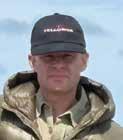
Jeff Berry of Port Orchard, Washington, is honored to be a candidate for the NALF Board of Directors. Jeff earned his degree in Agricultural Business from Colorado State University in 2005, where he gained valuable experience working with a variety of Limousin operations. After graduation, he returned home to begin a career as a forester with Western Timber Inc. while also operating Berry Cattle Co. with his wife, Holly, and their two children, Rowdy (15) and Radley (11).
Berry Cattle Co. focuses on raising high-quality Limousin, LimFlex and Angus cattle to meet the diverse needs of the beef industry. With a carefully managed herd of 40 cows, Jeff and his family emphasize precision in genetic selection, marketing cattle to junior show families, seedstock producers and bull buyers alike.
The Limousin breed has always held a special place in Jeff’s heart. Since becoming a NALF member in 1990, he has participated in numerous junior nationals and national shows, and today he is grateful to share those same experiences with his sons. Together, the Berry family has raised several junior national champions, carrying on a tradition of excellence in the show ring.
Outside of cattle, life is full and busy for Jeff and his family, with wrestling commitments and a steady schedule of cattle shows. Through it all, Jeff remains passionate about serving the breed. Jeff is honored to be given the opportunity to support, encourage and bring his knowledge of the breed and industry to the NALF board, it would be a true pleasure.
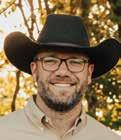
Riley Laber, of Hillsboro, Ohio, serves as the East Region Seed Manager for Nutrien Ag Solutions. Alongside his wife, Kayleesue, he operates a successful herd of registered Limousin cattle in Ohio. Their three children — D’lelah, Patton, and Denver — are actively involved in the family operation and have found success both inside and outside of the show ring, making cattle not just a business, but a shared family passion.
Riley takes great pride in traveling the country with his family to exhibit their cattle, promote the Limousin breed, and create lasting memories together. Originally from Parkston, South Dakota, he grew up deeply rooted in agriculture and now blends that heritage with his professional role and family livestock operation. By balancing his career with his commitment to raising quality cattle, Riley is dedicated to advancing the beef industry and inspiring future generations to continue its growth.
Curt and his wife Leanne operate Wieczorek Limousin in Mount Vernon a diversified farming/ranching operation in southeastern South Dakota. They are the 4th generation to operate the land since it was homesteaded in 1882 by his great grandfather.

Wieczorek Limousin hosted their first bull sale in 1981 and have continued to do so every year since making it one of the longest running Limousin production sales in the country.
Curt has served in several organizations in various capacities which includes nearly 20 years serving on his local township board, and presently serving as chairman of Custom Genetics Solutions, LLC board of directors, a custom bovine semen collection facility located near Mitchell, South Dakota. He has also served the Limousin breed in various state and national capacities.
Curt has three daughters, three sons-in-law and three granddaughters. He enjoys spending time with family and fly fishing in his spare time

FEBRUARY 15, 2026
Selling Limousin • Lim-Flex • Angus Bulls • Bred Females • Open Heifers
Official Publication of the North American Limousin Foundation
2005 Ruhl Drive • Guthrie, OK 73044
405/260-3775 • Fax: 405/260-3766 www.Limousin365.com
Publisher: L365
PUBLISHER EMERITUS—Dan Wedman
PUBLISHER EMERITUS—Dale F. Runnion
EDITOR—Kyle Haley
ADVERTISING MANAGER—Lindsey Meyer
CIRCULATION—Jeri Duerr
ART DIRECTOR—Ricki Rookstool
FIELD STAFF:
NORTH REGION—Claire Hubbard 765/404-8458 • Claire@Limousin365.com
SOUTH REGION—DeRon Heldermon 405/850-5102 • Deron@Limousin365.com
U.S. ___ $30 (1 year) ___ $40 (2 year) ___ $52 (3 year)
INTERNATIONAL ___ $40 (1 year, Canada) ___ $50 (1 year, Surface Mail) ___ $100 (1 year, Air Mail)
All payments to be paid in U.S. Dollars

L365 reserves the right to refuse any advertising or copy at its sole discretion. L365 assumes no part in guaranteeing the integrity or character of any advertiser.
L365 accepts no responsibility for the accuracy of any photographs except those of the staff. L365 cannot be held responsible for the content of submitted advertising.
Freelance Manuscripts & Photographs: L365 publishes news and educational material about Limousin cattle, of use to and about their owners. Contributors are invited to submit material of this nature. Preference will be given to material that is accompanied by photographs or appropriate illustrations. Manuscripts accepted for publication are subject to editing and revision to meet requirements for publication. Send manuscripts to: Editor, L365, 2005 Ruhl Drive, Guthrie, OK 73044.

The 2026 National Junior Show & Congress is sure to be a rockin’ event for all Limousin enthusiasts. The funds raised by the bidders, buyers and donors in the Credit For Kids event will positively impact the junior show. We hope to see you all in Ohio.
Thank you for continuing to support Limousin youth!

Aaron Whittington
ATAK Limousin
BCV Farms
Beckman Livestock & Farming
Bill Franke
Boyce-Dill Cattle
Buck Ridge Cattle Co.
Coleman Limousin Ranch
Coyote Hills Limousin Ranch
Cross Creek Farms
Davis Ranches
Edwards Land & Cattle Co.
Glendenning J Bar J
Hunt Limousin Ranch
Jerry Henderson Cattle Co.
Jones Brothers Limousin
Keeton Limousin
Kyle Schmale L365
Lawrence Family Limousin
Lenape Limousin
Linhart Limousin
Long & Sons Limousin
Lonley Valley Seedstock
Mike Kuhlman NALF
Ochsner Limousin
Peterson’s L7 Bar Limousin
Pinnell Limousin
Red Rock Limousin
ROM’N Limousin
Sennett Cattle
Spring Creeks Cattle Co.
Symens Brothers
T4 Livestock
Victor Westendorf
Wieczorek Limousin
Wies Limousin
Wilder Family Limousin
Wulf Cattle
Entry Deadline: MAY 1, 2026

JULY 3-9, 2026
Late Entry Deadline: MAY 15, 2026
Pickaway Agriculture and Event Center • 415 Lancaster Pike, Circleville, OH 43113
Hotel Blocks Close June 6: Visit NALF.org for more information
On Saturday, June 21, 2025, applicants interviewed for open positions on the North American Limousin Junior Association (NALJA) Board of Directors. During the interviews, candidates shared their desire to serve on the board, the biggest influences in their lives and their future goals.
The newly elected officers and board members for the 2024–2025 year were announced at the awards ceremony on Wednesday, June 25, 2025, in Perry, Georgia.

Elected to lead as the 2024-2025 NALJA President is Boone Begert of Allison, Texas, son of Bret and Haley Begert. “I’m excited to serve as the NALJA President this year because its an opportunity to give back to the breed and the people who have helped shape me. The Limousin Junior Board is so important because it helps us grow as leaders, connect with other juniors, and keep building a strong future for our breed.” Boone is pursuing a degree at West Texas A&M University, majoring in General Ag and Agricultural Communications.
Eliza Truel
Eliza Truel will continue on the board as ex-officio. Eliza is from Skiatook, Oklahoma, and is the daughter of Bridget Hollopeter. “In
my last year on the NALJA board, I am looking forward to continuing to meet more junior members and breeders across the country and creating a closer connection with them. I hope to help with involvement in our association by learning from others around us.” Eliza is finishing her degree at Oklahoma State University, majoring in Animal Science Biotechnology.
Shane Kendall serves as the 2025-2026 Vice-President. Shane is the son of Dustin and Charmae Kendall from Magnolia, North Carolina. “The NALJA board has been an essential part of my life; it has taken
continued on page 60
Samantha’s time as a junior is coming to a close, and we couldn’t be more proud of the dedication, growth and grit she’s shown over the years. We’re incredibly thankful to everyone who has supported her along the way – in the barn, the ring and beyond.
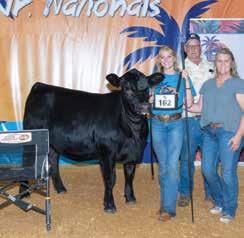


27th Bi-Annual Fall Bull Sale with Saturday, November 1, 2025 • 12:30 p.m. 4873 Lee-Jackson Highway • Greenville, Virginia

As one chapter closes, the heart of our operation remains the same – strong genetics, honest cattle and a deep-rooted love for this way of life.


T&J CATTLE COMPANY
Joe, Tabby and Samantha Moore 1688 Stingy Hollow

HE SELLS NOVEMBER 1
SJMR Maverick 420M ET 4/26/24 • Homo Black • Homo Polled • 56% LF RLBH Air Force One x TJMR Peaches 226Z Grand Champion Lim-Flex Bull at Eastern Regionals, Southeast Summer Classic and State Fair of West Virginia.


Opportunity knocks this fall at Straight Limousin.
We’re offering an elite set of show heifers and herd bulls available private treaty — first come, first serve.
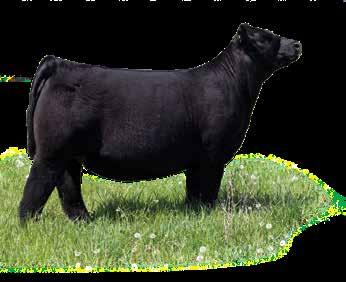
KVLN 2444K “Barbie”
S: TASF Heineken 405H
D: MAGS Walkin
Polled • Homo Black
62% Lim-Flex
Coming In Klutch
S: MRL Fonzie 847F
D: STLX Hope 051H
Homo Polled • Homo Black
60% Lim-Flex
SIRED BY
CELL Keystone
CELL-TNGC Hits The Mark
STAG Good Times
Conley No Limit
Coming in Klutch
EF Xcessive Force
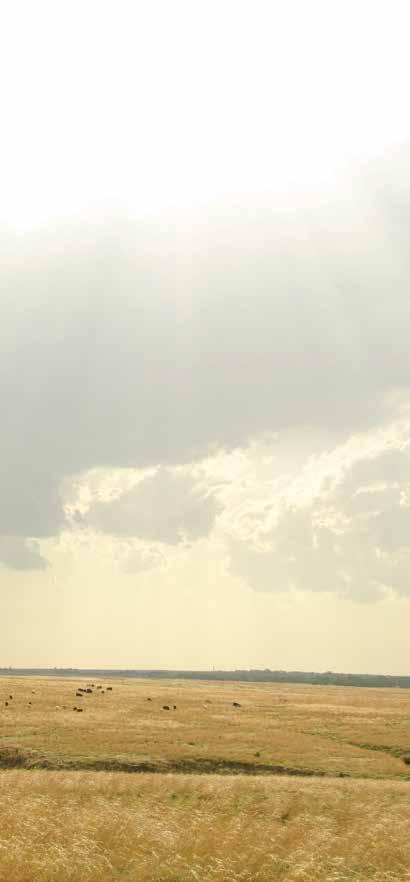
continued from page 58
me places I never could have imagined, as well as meeting people I never thought I would have the pleasure of knowing. The best part for me is being able to attend shows with more familiar faces than I ever knew before, and people I know I can count on to continue making the Limousin breed successful.” Shane is attending Northeastern Oklahoma A&M College and is participating on the Livestock Judging Team.

Backed by breed-leading sires and generations of selection pressure, this set is bred to perform in the show ring and the pasture. Don’t miss your chance to add proven Straight genetics to your program.
Jay & Lori Straight
712-592-1350
2173 Morgan Ave. Logan, IA 51546
Dave Book
563-320-7343
Kason Kiser of Lufkin, Texas, was re-elected to the NALJA Board of Directors after serving a one-year term. Kason is the son of Terry and Joanne Kiser. “I am glad to have been chosen for another year on the NALJA Board and look forward to another year of growth both personally, as a board, and as a Junior Association. My first Junior Nationals was just three years ago in Amarillo. The Texas crew welcomed me with open arms, and it was exciting to see the interaction of the members of the NALJA Board and how they guided and inspired the other members. Now I get to be part of that. The number of friendships grows with every show I attend; my fellow Board Members have become true comrades, and we get to inspire new and younger members and watch them grow as showmen, cattlemen and individuals. We truly represent one of the greatest, most versatile breeds in the country, but at the end of the day, NALJA isn’t just about the cattle; it is about the young people who will grow up to steward these cattle that we love in the future!”
“I’m excited to continue to be a National Director to help grow the Limousin breed and Junior Limousin Association. I look forward to building relationships within the breed, promoting the junior shows and improving growth. In addition, I want to recruit more Juniors to be involved in the Junior Limousin Association.” Wyatt Jacoby is the son of David and Jennifer Jacoby of Paradice, Texas. Wyatt plans to study Ag Business and Biology at Texas Tech University. Wyatt was reelected to the NALJA Board of Directors after serving a one-year term.
Brandt is the son of Jeff and Amy Gazaway, Stillwater, Oklahoma. “Over the past year of being on the board, I’ve had the opportunity to travel across the country to meet Limousin juniors and make countless memories. Now going into the second year of my term, I am even more excited to spend this year with the Limousin family and get more juniors involved with activities.” Brandt is majoring in Agriculture Leadership with a minor in both Animal Science and Ag Business at Oklahoma State University.
“I am beyond excited to serve on the NALJA board this year! I look forward to giving back to the industry, creating new memories and friendships, and embracing all the opportunities that lie ahead.” Cora plans to attend Wilmington College to pursue a degree in animal science to become an embryologist. Cora is the daughter of RD and Rachel Burns from Macy, Indiana.
continued on page 62





















• Entries due by 12.1.25
• Pictures & Videos due by 12.15.25
• All bulls ‘MUST’ be exhibited in the “Yards or on the Hill”.
• Females ‘NOT’ required to be exhibited at National Western.
• Each contributor must have a representative present at the sale event.
* Contact sale management for sale regulations, entries & competition information.
2005 Ruhl Drive • Guthrie, OK 73044 405/260-3775 • Fax: 405/260-3766 www.Limousin365.com
FULL PAGE
2/3 PAGE
1/2 PAGE
1/4 PAGE
All advertisements are 4-color process
$1,225
January - Spring Sale Edition Dec. 1 Dec. 23
April - Herd Bull Edition Mar. 1 Mar. 25
July - Breeder Directory Edition June 1 June 25
October - Fall Sale Edition Sept. 1 Sept. 25
Advertising materials to Kyle Haley 405/260-3775 • kbhaley2@gmail.com
CLOSING DATES
Refer to listing above.
ADVERTISING SKETCHES
Requests for advertising layouts must be in the L365 office 10 days before copy deadline.
TERMS
All accounts are due and payable as billed. Interest charges of 1-1/2% per month (18% APR) will be assessed to 30-day unpaid accounts. Customers with overdue accounts will be put on a prepay basis for subsequent advertising business.
CONTRACT DISCOUNT
L365 contracts for 4-time print and annual digital/print combinations are available at substantial discounts. Contact the L365 field representative in your area or call the L365 office at 405/260-3775.
DIFFICULT ADS
Ads requiring substantial extra production work will be assessed extra charges at standard shop rates. If you prefer no extra charges, request us to simplify the ad at our discretion if necessary.
COPY CHANGES
Alterations in advertising copy, if requested after closing date, will be made only if time permits.
REPRINTS
Advertising reprints are available. Requests for reprints must be made at the time the order for the ad is placed.
All other questions, contact the L365 office.
“Throughout my life, I have consistently made a point to pursue activities that not only enable me to make a positive impact on those around me, but also enhance myself as a person and a leader. The NALJA Board has done all of these things for me. I am grateful for my time on the board so far, as it is fulfilling to connect with and build lasting relationships among our junior members. I look forward to continuing to form these relationships throughout the next year!” Turner is the son of Roger and Monette Sanders. Turner is currently attending Texas A&M University, majoring in Animal Science.
Corbin is the son of Loni and Chas Robbins from Chattanooga, Oklahoma. “I am excited to be a part of the NALJA Board for the upcoming years. I am especially looking forward to interacting with the youth in our breed!” Corbin was elected to the NALJA Board of Directors at the 2025 NJLSC. Corbin plans to continue his education at Texas A&M University, studying Agricultural Economics and Pre-Law.
“I am excited to be on a team of outstanding members that bring so many positives to the cattle industry, where we can boost the junior programs. I am excited to grow personally and professionally and gain new leadership skills.” Bailey is the daughter of Melissa and Jerrod Haddon from Reelsville, Indiana. After high school, Bailey plans to pursue a degree in Animal Science and Agricultural Communications.
Samantha Pecco is the daughter of Autumn Patton and Nathan Pecco from Ewing, Kentucky. “Ever since I was little, I have always looked up to the junior board members. I thought they were the coolest people in the barn, and I wanted to be just like them. I saw the difference they made and knew how much the other juniors looked up to them, and knew it was an opportunity I wanted to have. Being able to be a role model for juniors and an advocate for producers is a dream come true! I am looking forward to planning the NJLSC and finding new ways to highlight and involve not just juniors, but the breeders and producers that keep our breed thriving.” After high school, Samantha plans to attend college to major in Political Science and Animal Science.
Mikaya Askey and Landry Kleman both completed their service on the NALJA board. While serving, they strived to always put the juniors first and looked for ways to improve the association. Thank you for your service, your dedication, and the joy you added during your time as board members. We wish you nothing but the best in your future endeavors. You will both be missed!
“I am excited to serve the Limousin juniors this year alongside a great group of young adults. We are looking forward to setting new goals and bringing new ideas to the breed! If you need anything, please don’t hesitate to reach out!” said Tatum Swink, NALF Director of Activities. continued from page 60

ECONOMIC ANALYSIS FOR FEEDING PERFORMANCE AND CARCASS GRID RESULTS
• 216 HEAD OF CATTLE RAISED ON TWO MONTANA RANCHES THEN FED AND HARVESTED ON RESEARCH AT SDSU
• CALVES SIRED BY PROVEN LIMOUSIN, LIMFLEX, AND ANGUS A.I. SIRES (1/3 EACH) ON COMMERCIAL ANGUS COWS.
• CALVES SPLIT EQUALLY INTO 3 HARVEST GROUPS (200, 235, 270 DAYS ON FEED)
• RESULTS REFLECT FEEDING PERFORMANCE AND CARCASS GRID PERFORMANCE
• LIM-FLEX SIRED CALVES GENERATED $23 MORE PROFIT PER HEAD; LIMOUSIN SIRED CALVES GENERATED $27 MORE PROFIT PER HEAD THAN THEIR STRAIGHTBRED ANGUS COUNTERPARTS DUE TO THEIR ABILITY TO ACHIEVE SIMILAR QUALITY GRADE WHILE IMPROVING FEED EFFICIENCY AND YIELD GRADE.

NALRF/SDSU RESEARCH COMPLETED 2025

Aby Alison Jones NALF Director of DNA Processing & Accounting Operations
s we start a new fiscal year here at NALF, we are happy to enter the fall season with a reduction in rates for DNA testing. If you have not already explored genomic testing for your herd, now would be an excellent time to start. With bull sale season around the corner, now is the time to collect DNA samples on those bull prospects and get them tested.
Genomically-Enhanced EPDs are the result of data compiled from genomic profiles of cattle as well as pedigrees and collected performance data The field of genomics studies the structure, function and sequence of the genome of these cattle. With modern technology, this data helps put together a highly individualized profile for Limousin cattle to depict a more accurate representation of their genetic worth as parents (measured with EPDs).
Instead of waiting until an animal is old enough to have multiple sets of progeny on the ground, DNA can be collected on bull and heifer calves at birth. After running the 100K profile, along with analyzing phenotype and pedigree, breeders can focus their efforts on developing their best bulls and heifers. Growth, maternal and carcass traits are available in one report. This allows breeders to improve each generation as they come. In the past, growth EPDs relied on the collection of weaning and yearling weights of progeny, and carcass EPDs required slaughter data of progeny to be generated.
Genomically-enhanced EPDs allow breeders to determine genetic merit at birth, as opposed to investing feed, land and other monetary resources to identify elite seedstock. It should be noted, it is still crucially important to collect performance data on cattle. In fact, the implementation of genomic technology probably makes it even more important than before.
As of September 1, 2025, NALF is offering the Neogen 100K for $42. This product utilizes 100,000 markers to generate EPDs, and is what is required for AI sires and donor dams (along with parent verification for AI sires and sire verification for donor dams). Parent verification alone is $36, so for an extra $6 per head, breeders can receive genomically-enhanced EPDs as well. Additionally, color and polled add-ons are priced at $10 each, making this product an excellent value for breeders.
Modern science and technology are advancing agriculture every day. The collection of DNA and performance data has helped make great strides in the Limousin breed to help producers cut costs by culling inferior animals at a young age, as well as making wiser selection and breeding decisions. The NALF staff is dedicated to providing the best customer service possible to our breeders. If you would like to discuss the best testing protocols for your herd, have registration questions, or would just like to chat, please feel free to call or email any time.
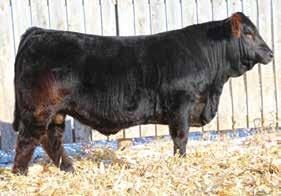
Purebred • Homo Polled • Black
SYES Easy Going 77E x Miss SYES Backstage 32H
CE: 9 BW: 0.6 WW: 74 YW: 114
MK: 23 CM: 6 SC: 1.00 DC: 16 YG: -0.51
CW: 29 RE: 1.27 MB: -0.33 $TPI: 89

Purebred • Homo Polled • Red
TREF EZ Street 107E x TREF Gemma 577G
CE: 11 BW: 0.1 WW: 72 YW: 106
MK: 30 CM: 8 SC: 0.85 DC: 10 YG: -0.49
CW: 51 RE: 1.46 MB: -0.25 $TPI: 133

Purebred • Homo Polled • Red
Wulfs Devils Lake K118D ET x Miss SYES Worktime 66B
CE: 15 BW: 0.4 WW: 73 YW: 121
MK: 27 CM: 8 SC: 0.20 DC: 16 YG: -0.52
CW: 49 RE: 1.48 MB: 0.01 $TPI: 136
Semen available through Heritage Genetics (605)237-2127.
Mark Your Calendar 46th Annual Muscle Up For Profit Sale
FEBRUARY 26, 2026 • 1 PM At The Farm • Amherst, SD Selling 100 Bulls & 25 Females


Purebred • Homo Polled • Red
Anchor B Gold Rush 48G x JBV Girl Crush 422B CE: 3 BW: 4.0 WW: 75 YW: 113
MK: 33 CM: 3 SC: 1.20 DC: 15 YG: -0.53
CW: 36 RE: 1.43 MB: -0.24 $TPI: 110

Purebred • Homo Polled • Homo Black
RUNL Rialto 135R x RUNL Evening Glow 205 E
CE: 12 BW: -0.3 WW: 93 YW: 139
MK: 19 CM: 9 SC: 0.60 DC: 15 YG: -0.41
CW: 54 RE: 1.17 MB: 0.00 $TPI: 134
Semen available through Grassroots Genetics (765)404-8458.
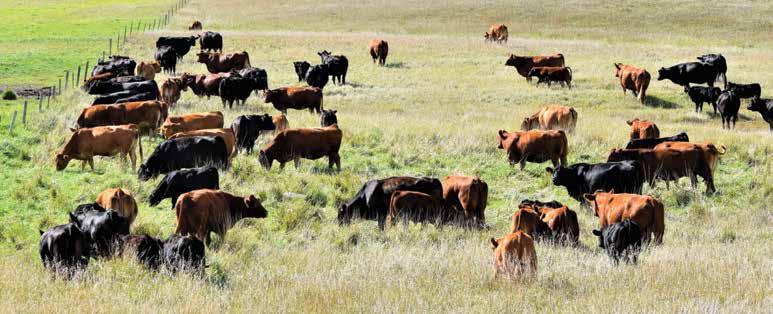
P.O. Box 155 • Amherst, South Dakota 57421

John: 605/880-8061 • Warren: 605/237-2127 Office: 605/448-2624 • jssymens@venturecomm.net Check Symens Bros Limousin on f for current information.


by Corbin Robbins NALJA Director
Sending greetings from southwest Oklahoma. I’m honored to serve as a newly elected member of the North American Limousin Junior Association Board of Directors. The Limousin breed has played a meaningful role in my life, and I’m thrilled to give back through this opportunity.
I would like to extend a big thank you to the Georgia, Tennessee and Florida Associations for hosting an outstanding Junior Nationals in Perry, Georgia, this summer. The hospitality and facilities were top-notch, and the experience was unforgettable. I’m already excited about Junior Nationals in Circleville, Ohio, July 3-9, 2026.
As the new show season kicks off, with state fairs happening across the country, I want to wish all Limousin breeders and showmen the
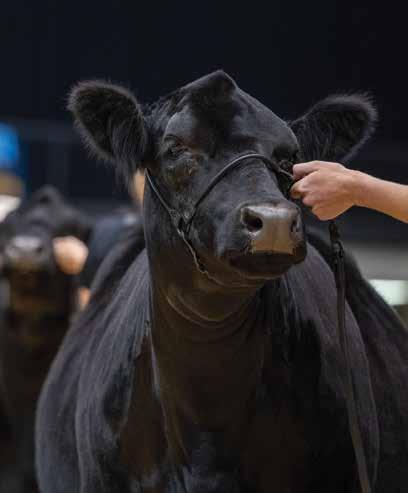

National Junior Limousin Show & Congress Circleville, Ohio July 3-9, 2026

best of luck. I look forward to seeing familiar faces and meeting new ones at upcoming shows across the country.
To all juniors: take the time to connect with fellow Limousin showmen and breeders every chance you get. Introduce yourselves, ask questions, and learn from those with experience. Be bold, be curious, and build friendships wherever you go.
I can’t wait to see you at a show or event soon. God bless!
PRESIDENT, Boone Begert Allison, TX boonebegert23@gmail.com
VICE PRESIDENT, Shane Kendall ..................................... Magnolia, NC skendall3795@mail.sampsoncc.edu
SECRETARY, Turner Sanders ........................................ Huntington, TX turnersanders05@gmail.com
TREASURER, Wyatt Jacoby Paradise, TX circlejlimousin@gmail.com
SOCIAL MEDIA CHAIR, Brandt Gazaway ......................... Stillwater, OK gazawaybrandt@gmail.com
EX-OFFICIO, Eliza Truel Skiatook, OK entruel@gmail.com
DIRECTOR, Cora Burns ............................................................ Macy, IN rdraccc@yahoo.com
DIRECTOR, Bailey Haddon Reelsville, IN mhaddon@ymail.com
DIRECTOR, Kason Kiser ......................................................... Lufkin, TX kdk1818@yahoo.com
DIRECTOR, Samantha Pecco Ewing, KY autumn.pecco@bnsi.com
DIRECTOR, Corbin Robbins ....................................... Chattanooga, OK lonirobbins@gmail.com
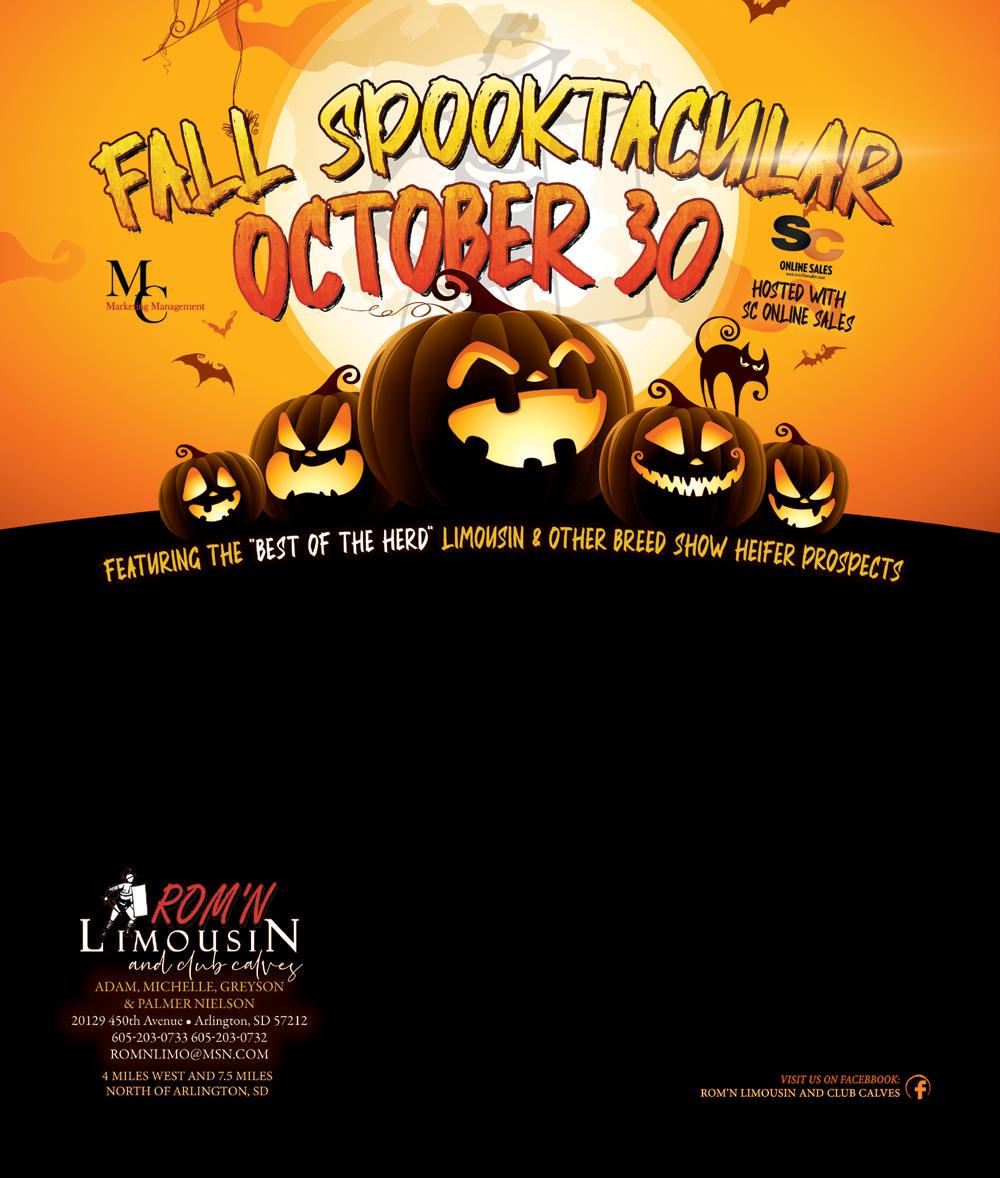

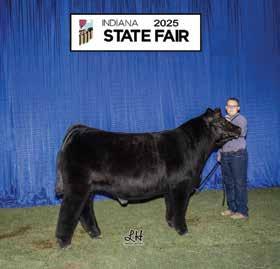
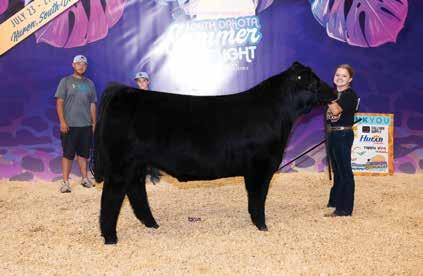
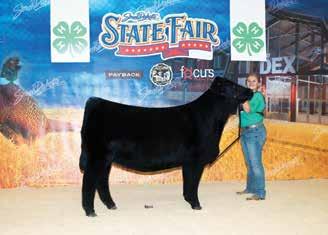
Bradley Cattle Co. Annual Fall Colors Female Sale, Springfield, MO
Coleman Limousin Discovery Sale Of 2025, Charlo, MT
Pembrook Cattle Co. Annual Fall Production Sale, Fairview, OK
Thomas & Sons Halloween Hunnies Online Show Heifer Sale, SC Online Sales
Farms Maternal Legends Multi Breed Open Heifer Sale, SC Online Sales
Sullivan Farms Multi Breed Bred Heifer, Donor Cow, Embryos, Pregnancies and Semen Sale, SC Online Sales
Balamore


Look what happens when you keep replacements from Leonard bulls.
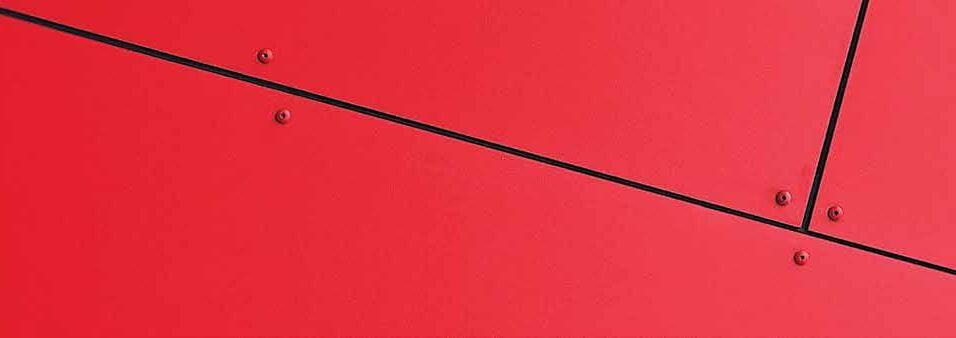

100 Registered Limousin, Lim-Flex, Angus Bulls
100 Bred Registered Limousin, or Angus Females Available

For 56 years, Leonard Limousin has built our program on a simple truth: when you buy a drill, it’s not the drill you want—it’s the holes and what they allow you to accomplish. The same is true with bulls. You’re not buying a bull, or even calves— you’re investing in profits. At Leonard Limousin, our goal has never been just to sell bulls. Our mission is to help you build profitable, sustainable operations that stand the test of time—just as Leonard Limousin has endured the challenges of more than half a century.
That philosophy has guided us since 1969, and it’s why over 80% of our bulls sell to repeat customers year after year. Leonard Limousin genetics are designed to deliver where it counts: efficient feed conversion, rapid growth, calm dispositions and the kind of consistency that turns into long-term success.
Whether you’re looking for your next elite herd sire or uniform groups of half-brothers to move your commercial program forward, Leonard Limousin is committed to providing the genetics that work as hard as you do.

MARK & SHERYL LEONARD
1362 Hwy. 59, Holstein, IA 51025
712-368-2611 work • 712-830-9032 cell
mark@agcomfinancial.com Al Morales, Herdsman • 712-304-2035
www.LeonardLimousin.com
In the Limousin Business Since 1969


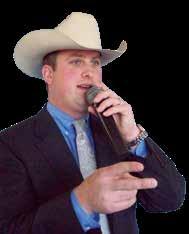


Afton, Iowa 50830
Phone: 641-782-3770 or 641-340-1676
Website: longandsonscattle.com • Facebook: Long and Sons Limousin Email: longandsonslimousin@gmail.com

DeRon Heldermon 405/850-5102 deron@limousin365.com
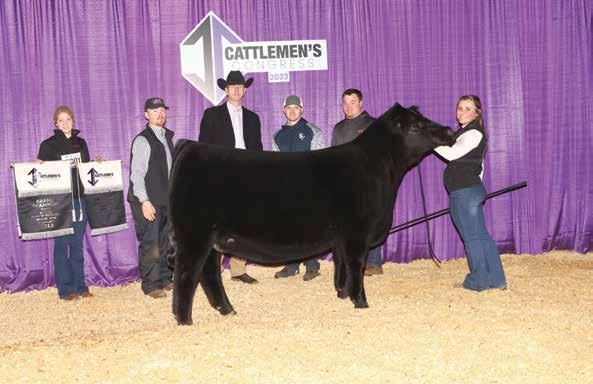




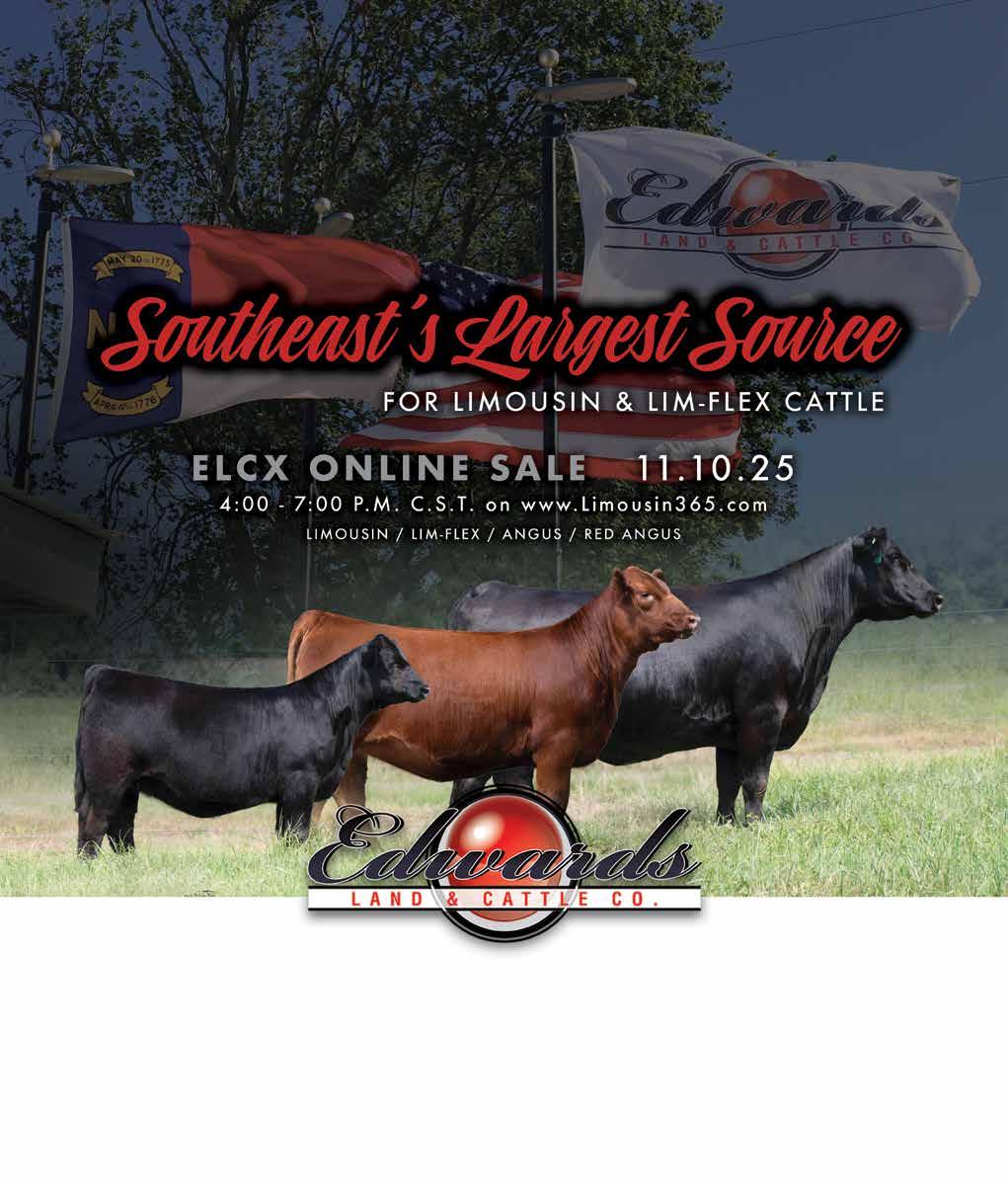
Consider these sires with leading genetics and values in the breed when making fall breeding decisions.
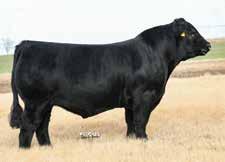



is just one phone call away!
LFL Johnny 1117 J
57% LF • HP • HB • LFL Deluxe Edition 6029D x LFL Gossip Girl 9168G



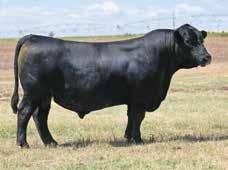



Bruce, Paula & Lee Roy Lawrence P.O. Box 299 • Anton, TX 79313
Bruce: 806/790-2535
Lee Roy: 806/778-0548 email: bll1@speednet.com www.lawrencefamilylimousin.com
Owned with Chris Deberry. Contact owners or Grassroots Genetics (515-965-1458) for semen.
LFL Jumper 1310J
76% Limousin • HP • Blk • COLE Genesis 86G x LFL Elise 7021E
Owned with Walking Spear Cattle. Contact owners or Grassroots Genetics (515-965-1458) for semen.
LFL Gamer 9116G
71% LF
HB
TMCK Cash Flow 247C x LVLS 9066U
Owned with Wulf Cattle. Contact owners or Grassroots Genetics (515-965-1458) for semen.
LFL Kujo 2130K
54%
HP
HB • MAGS Faultless 154F x LFL Georgie Girl 9013G
Owned with Buck Ridge Cattle Co. and Meredith Limousin. Semen packages available.
LFL Lover Boy 3151L
83% Limousin • HP • HB • Ratliff Jump Start 340J x LFL Fiesta 8126 F
Owned with Circle N Livestock. Semen packages available.
LFL Kryptonite 2066 K
77% Limousin
HP
HB • LFL Gamer 9166G x LFL Fiesta 8126 F Owned by Lawrence Family Limousin. Semen packages available.
LFL Krypto 2048K
57%
AHCC Hemi 0901E x AUTO Bliss 265Y Owned with Sun Up Limousin. Contact owners for semen.
LFL Genetic Values 9148G
50%
• Jindra Acclaim x LVLS 9066U Owned by Lawrence Family Limousin. Contact owners for semen.
DHIL Kole 021K (not pictured) 60%
COLE Deputy 37D x AUTO Bliss 265Y
LFL Esquire 7084E (not pictured)
MAGS Cable x AUTO Bliss 265Y
LFL Kelvin 2067 K (not pictured) 53%
LFL Esquire 7084E ET x MAGS Damzel Owned by Lawrence Family Limousin. Contact owners for semen. Call today about the volume discounts we have available.
Jonny, Amber & Colt Parkinson
3206 W St Road 114 • Levelland, TX 79336
parkinsoncattle@gmail.com
Amber: 806/773-6043
Jonny: 806/632-6859 www.parkinsoncattleco.com